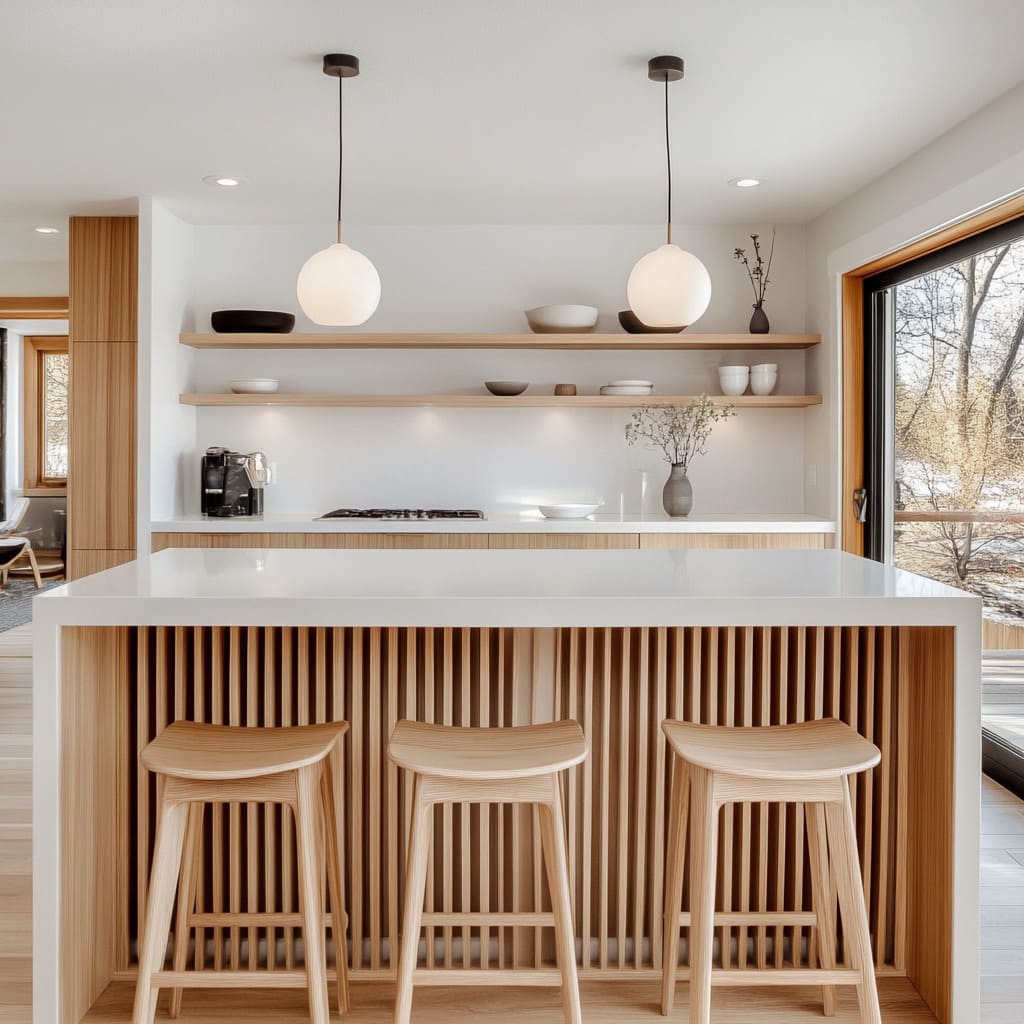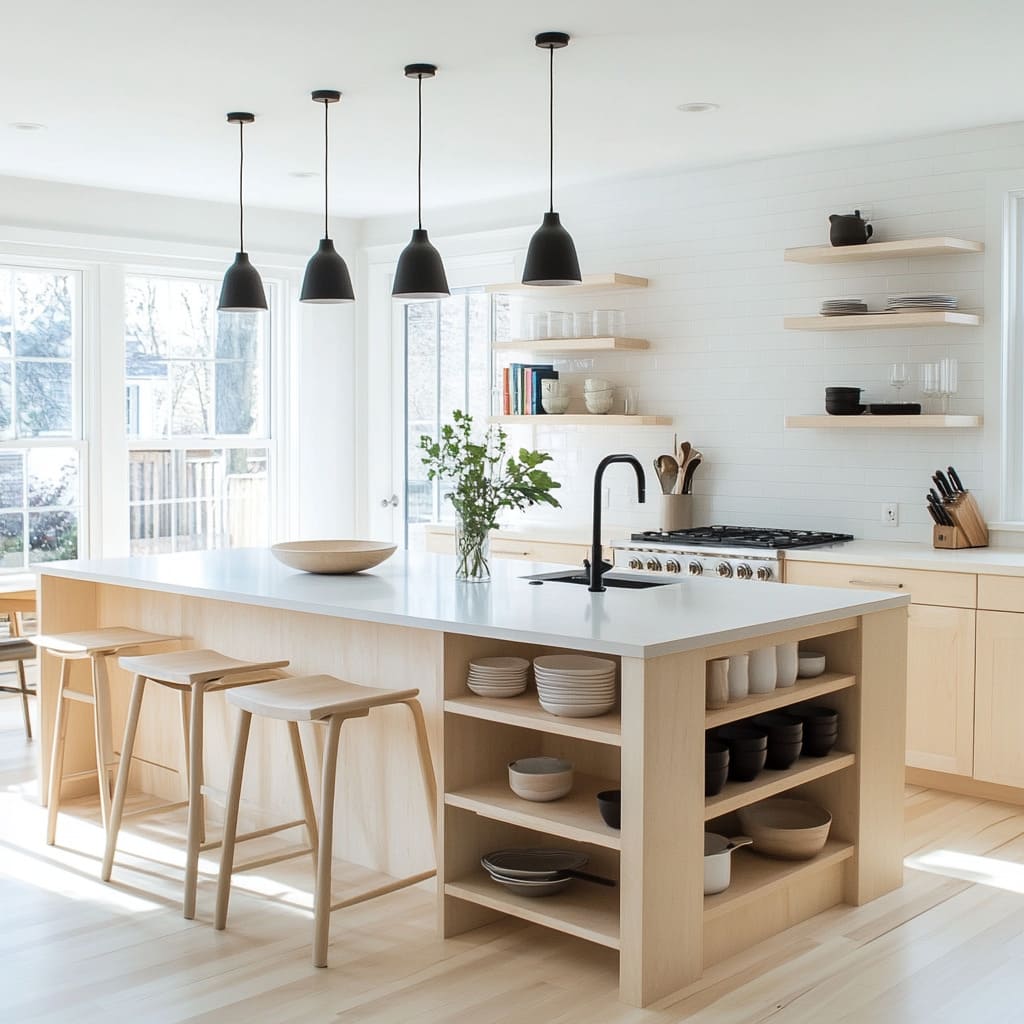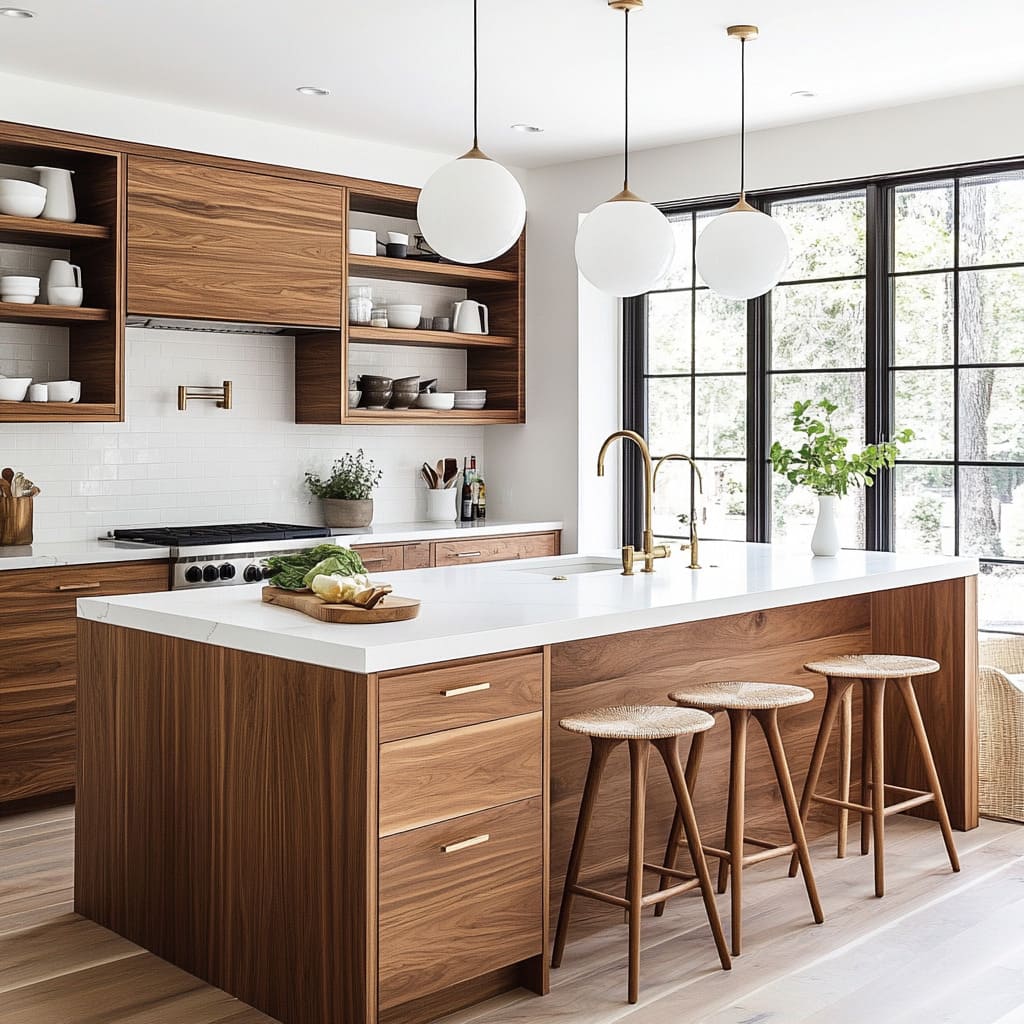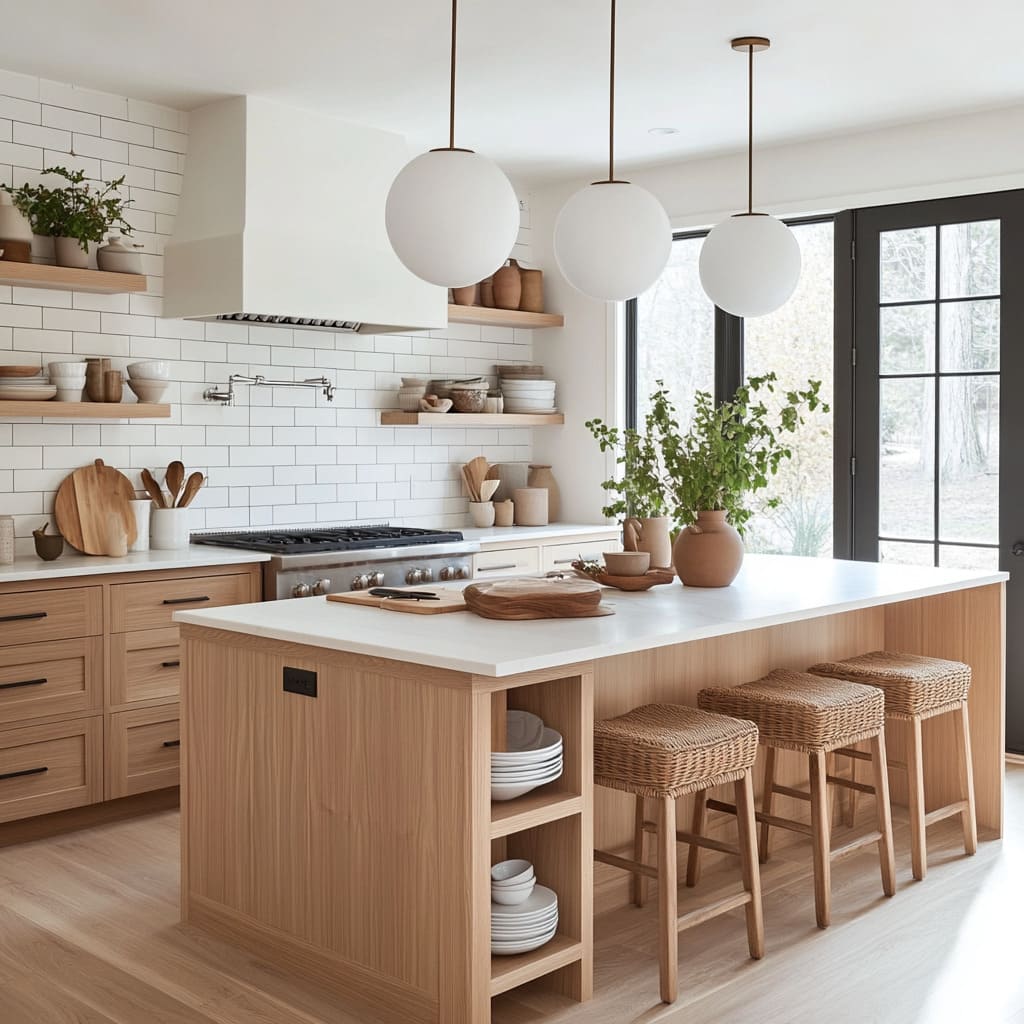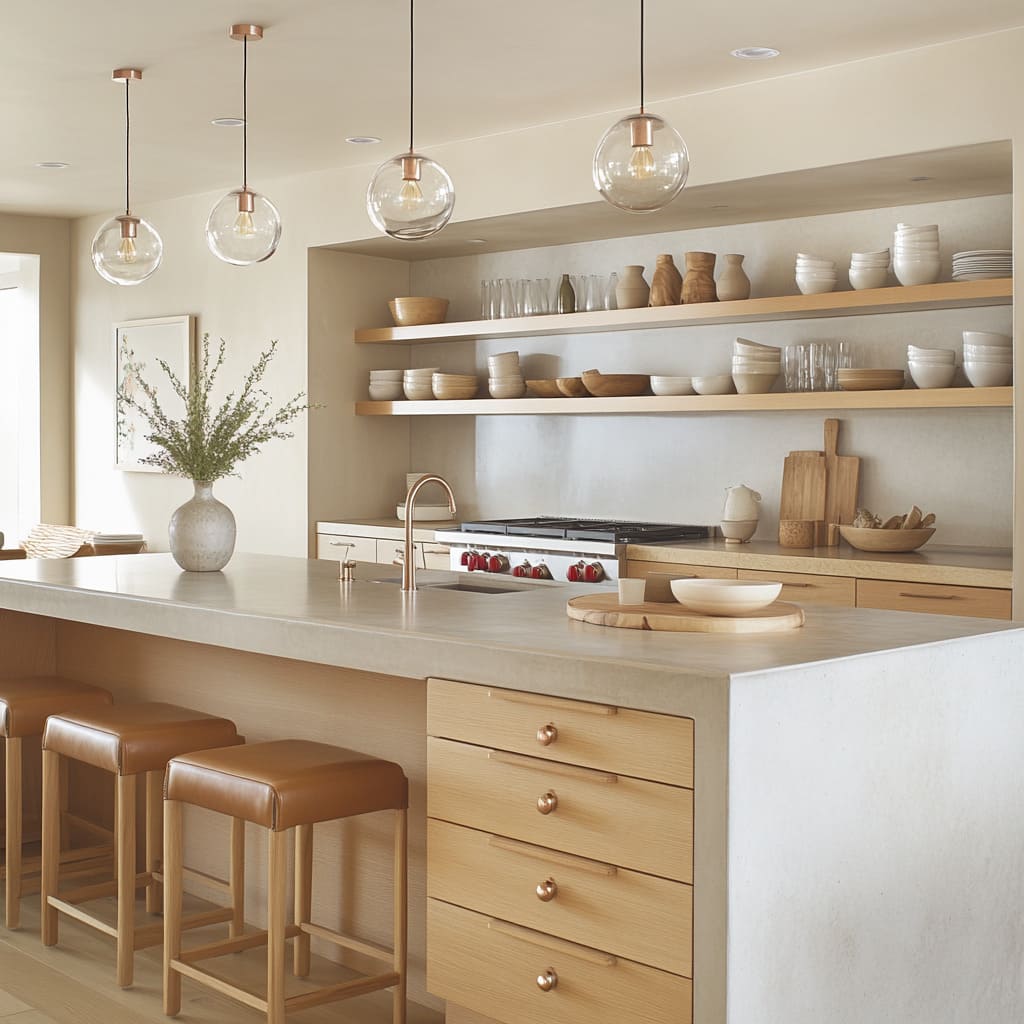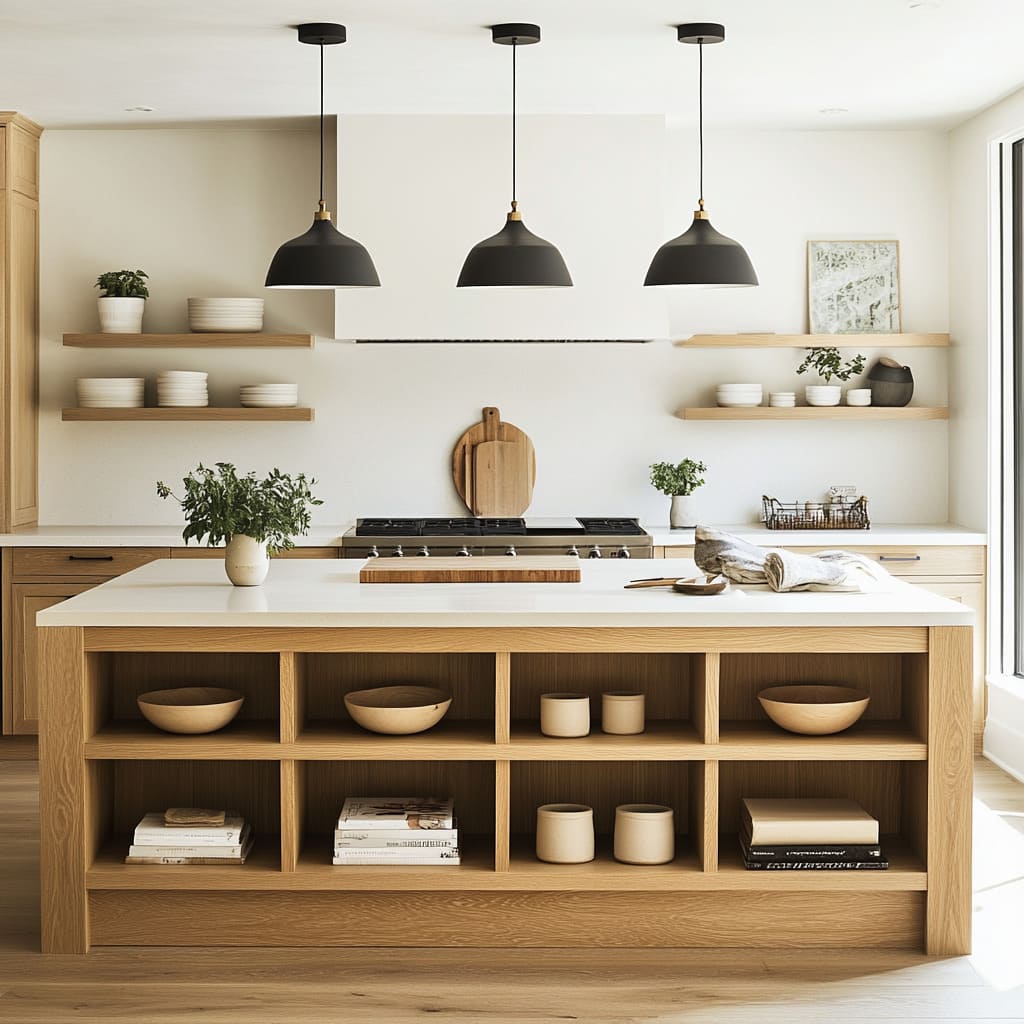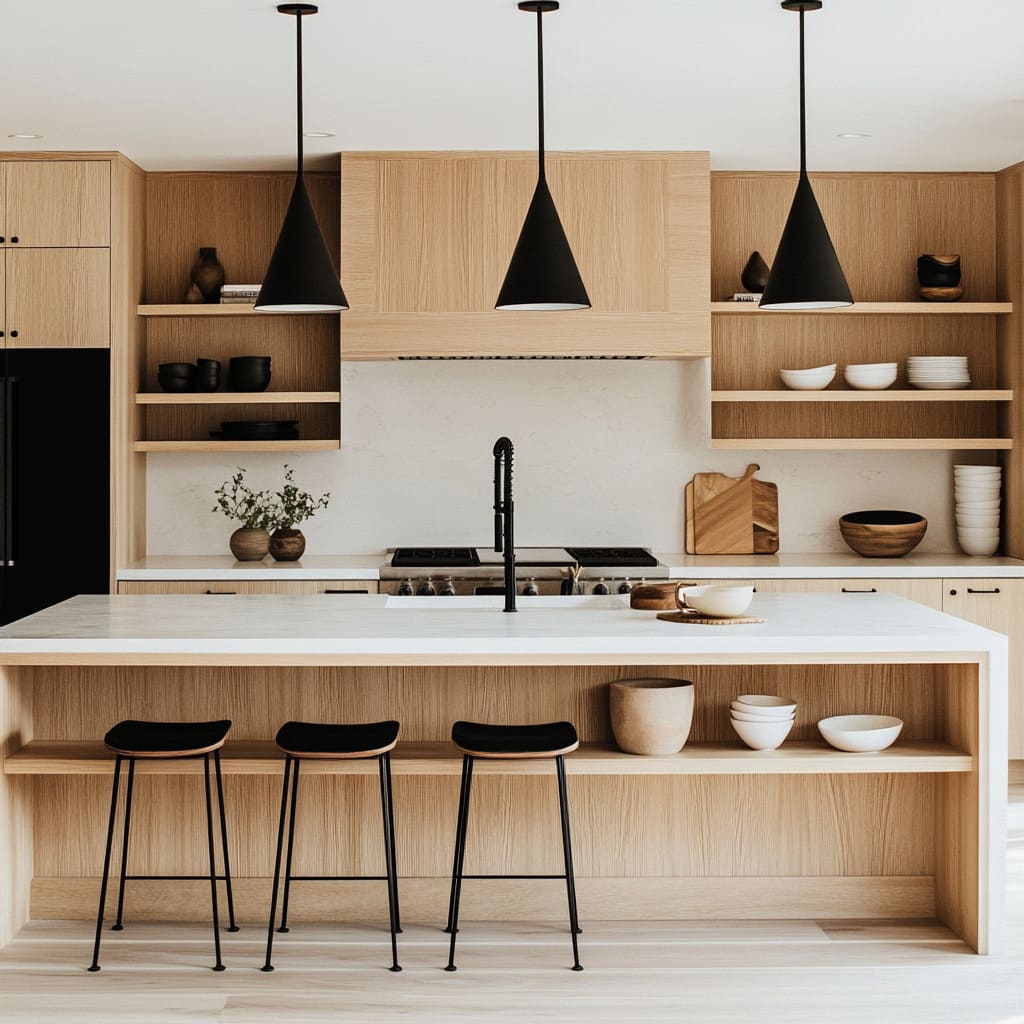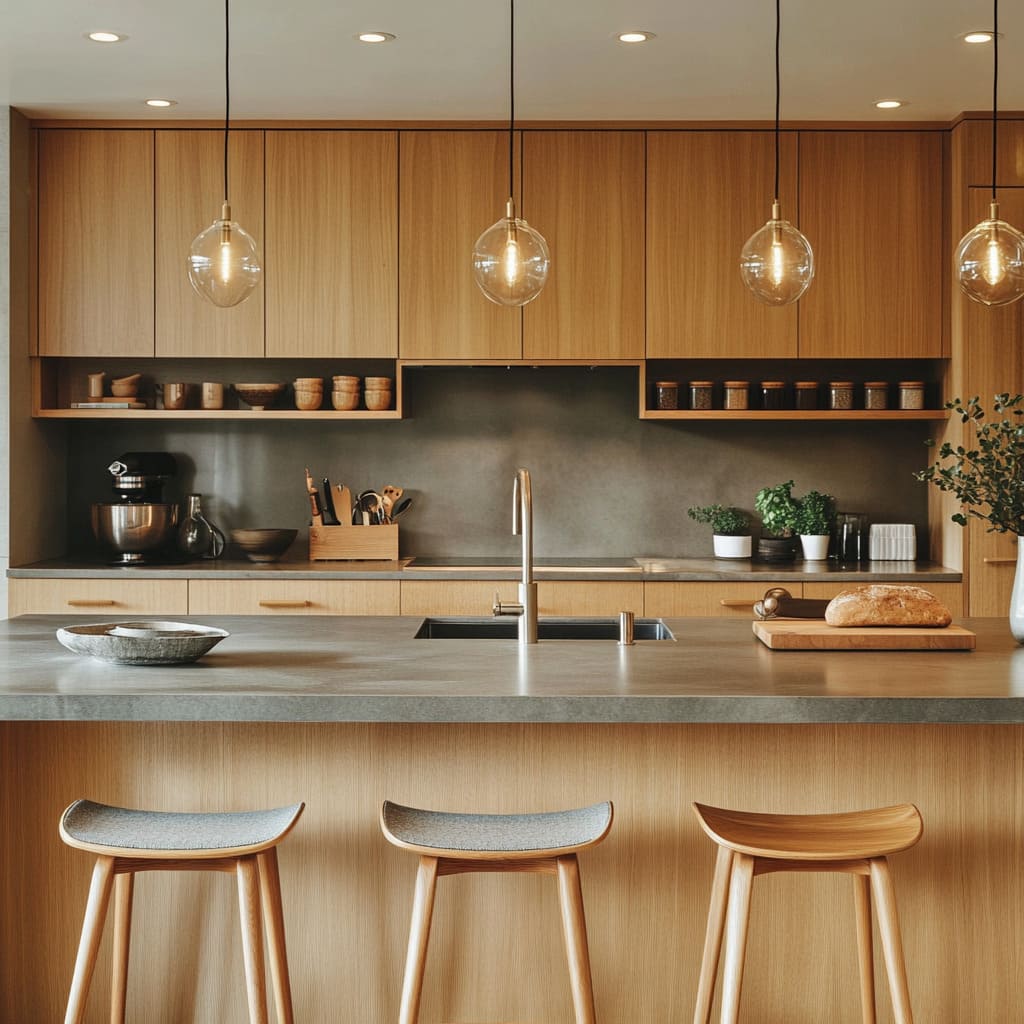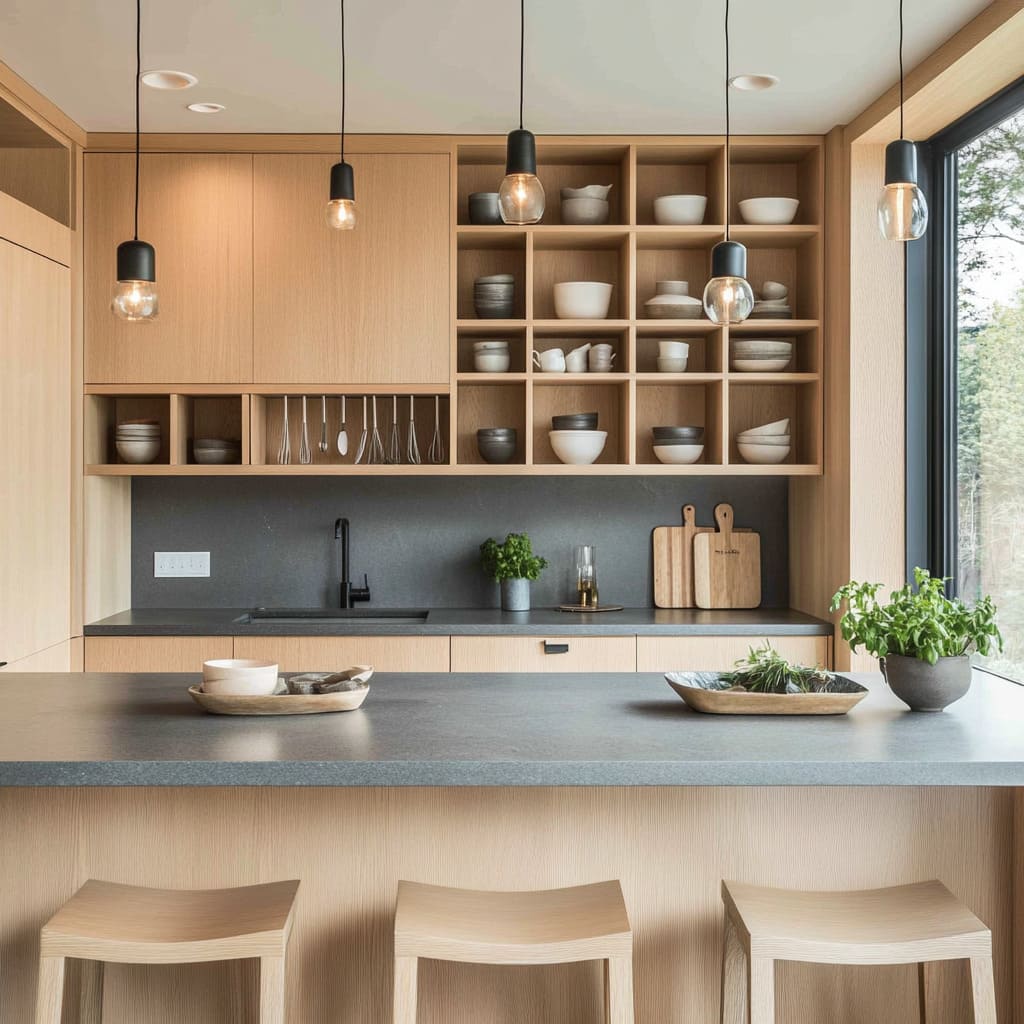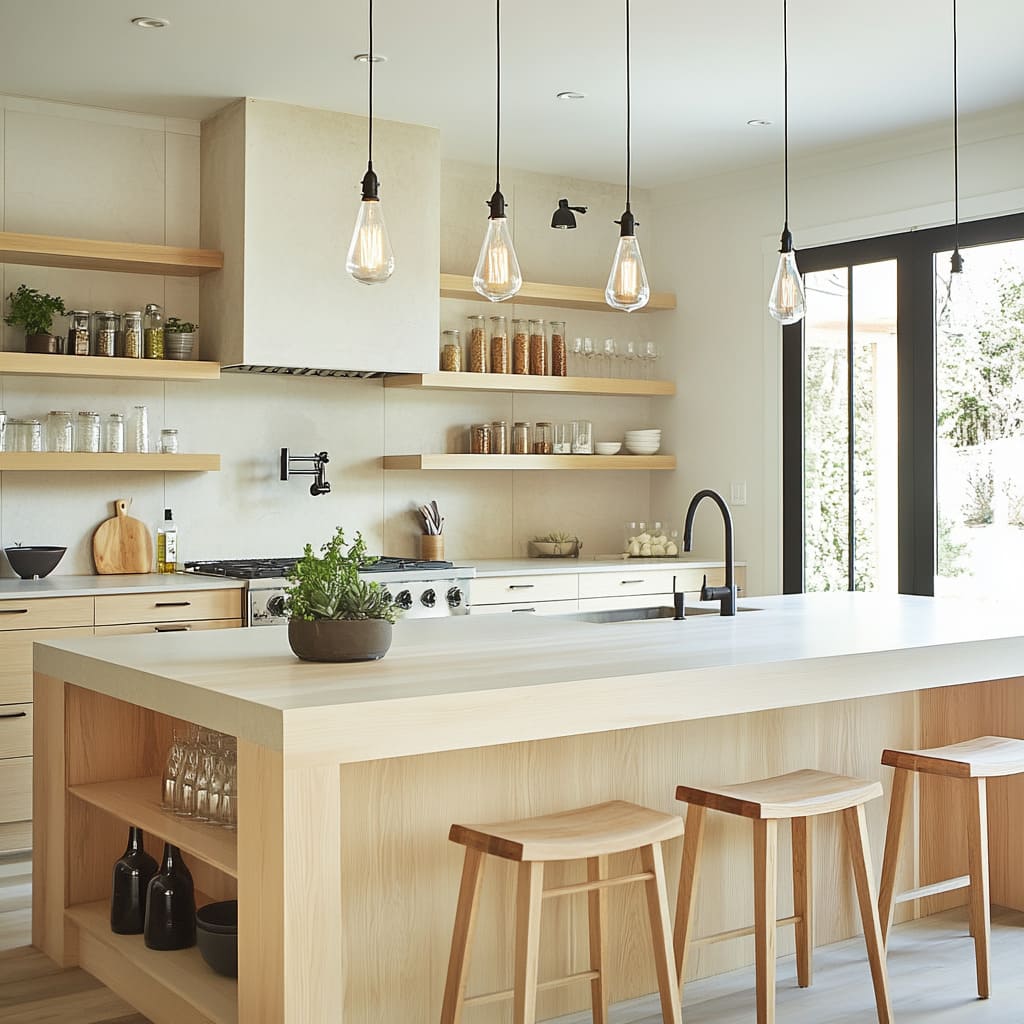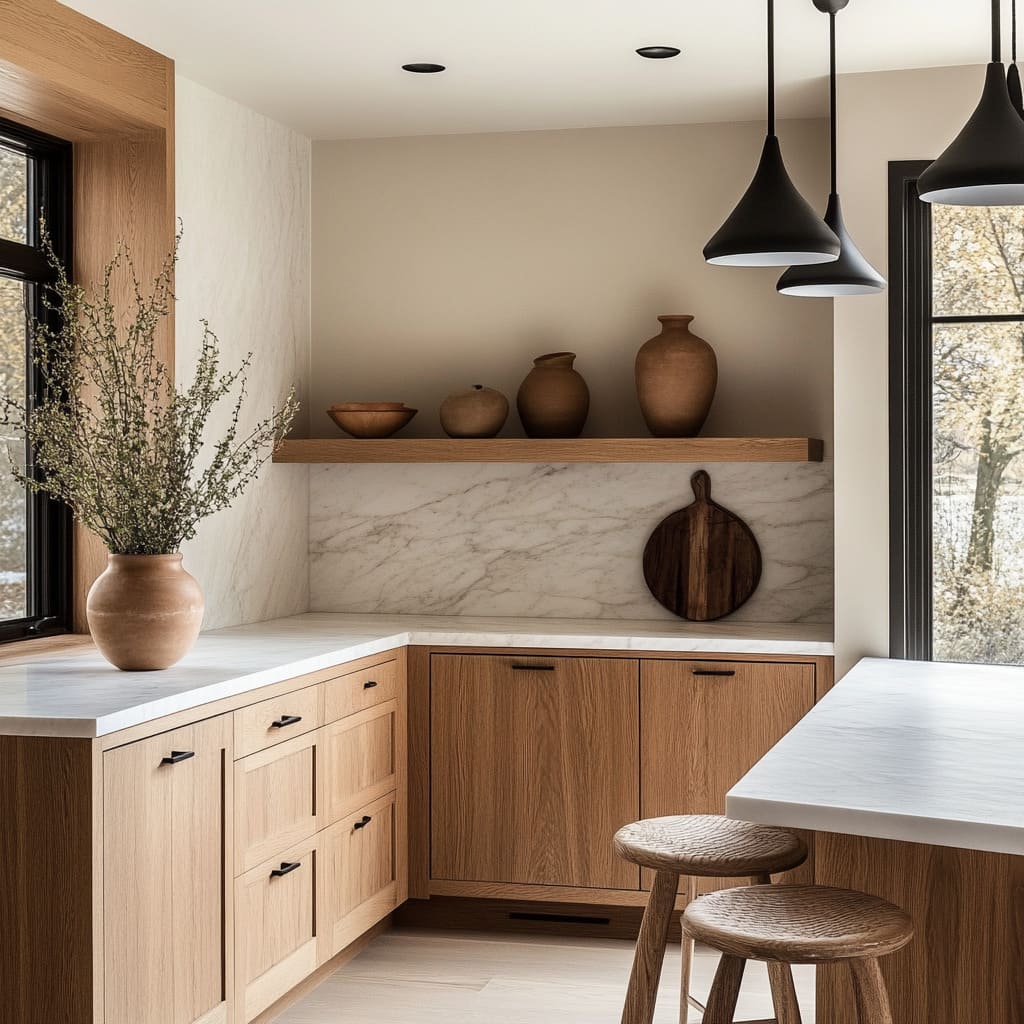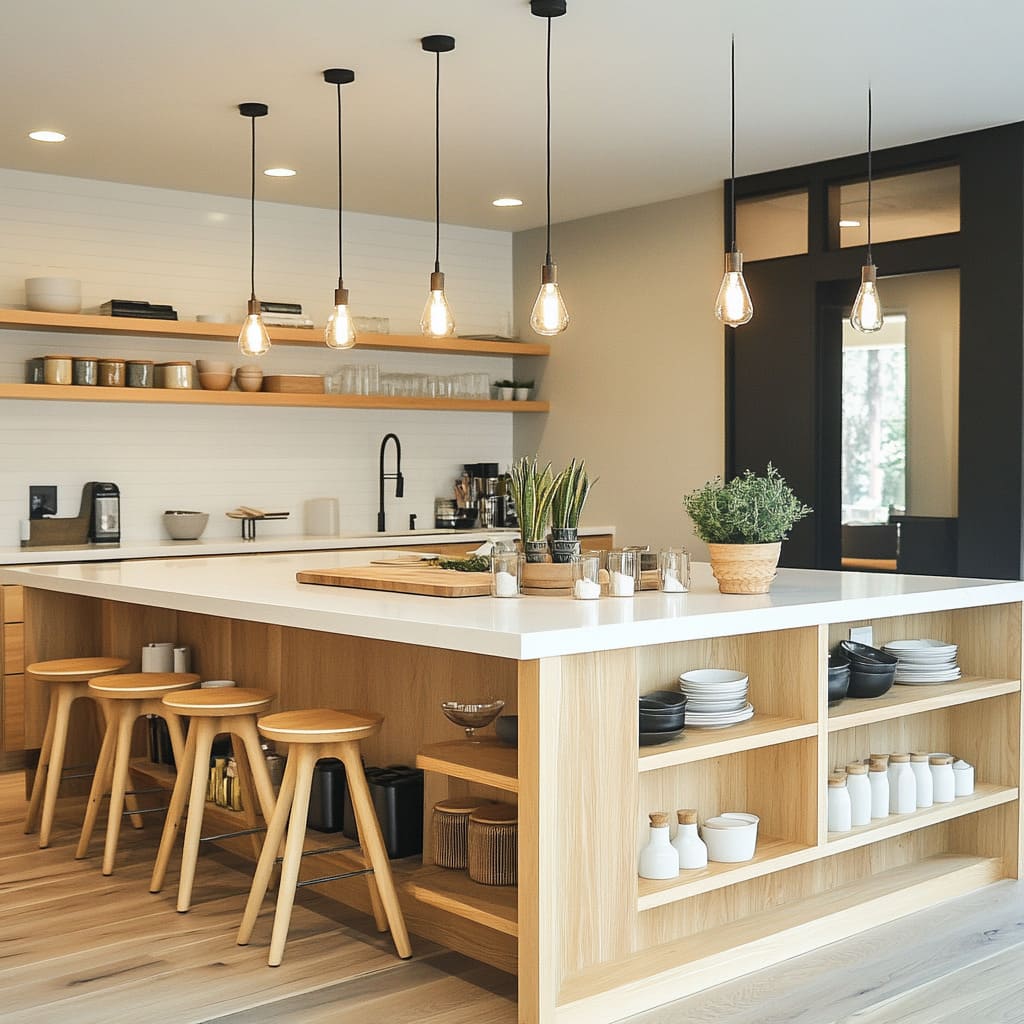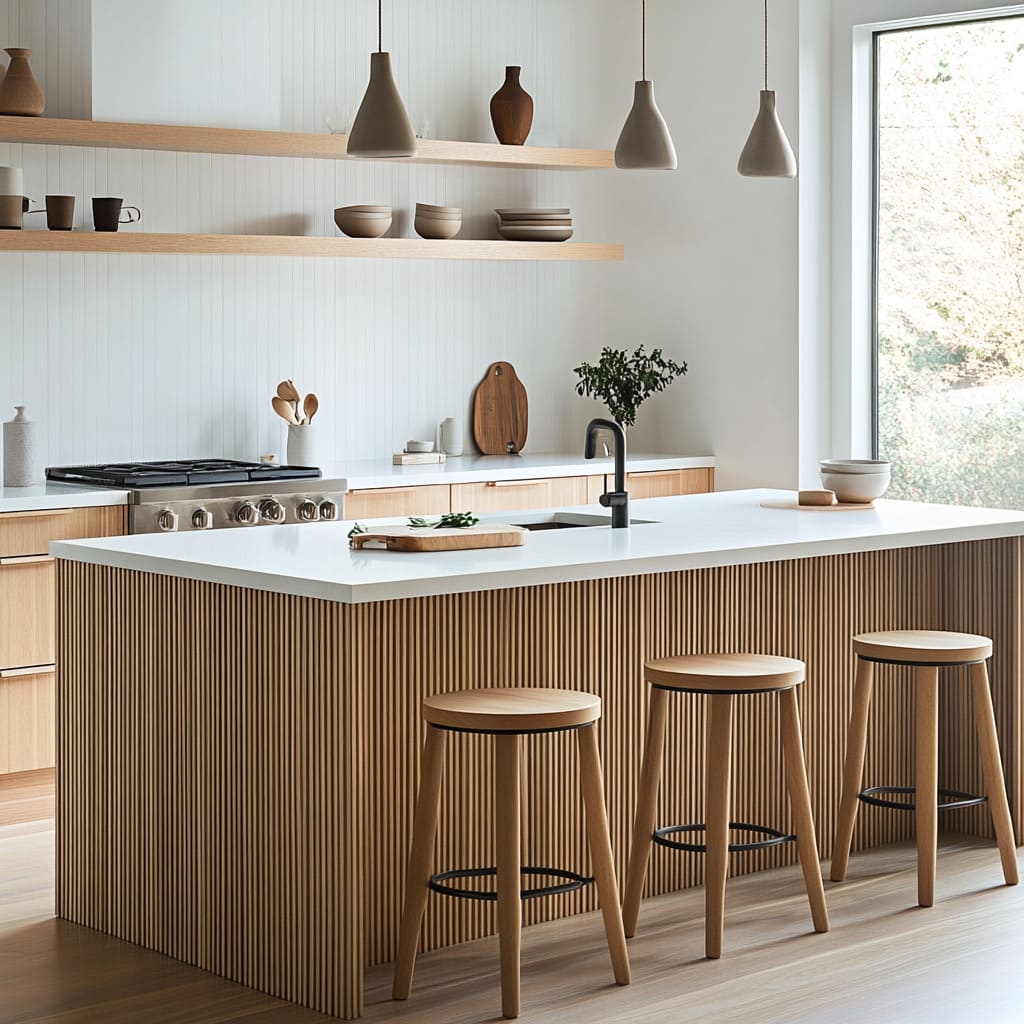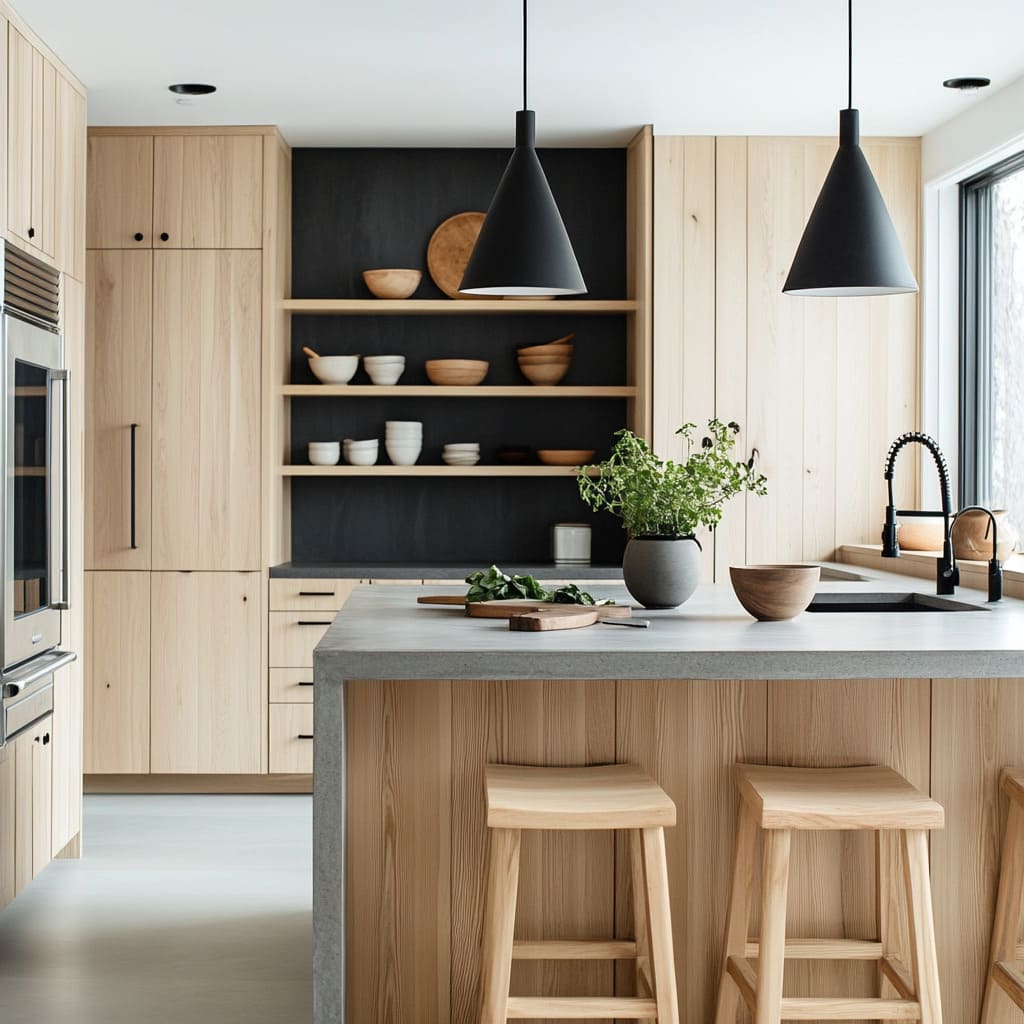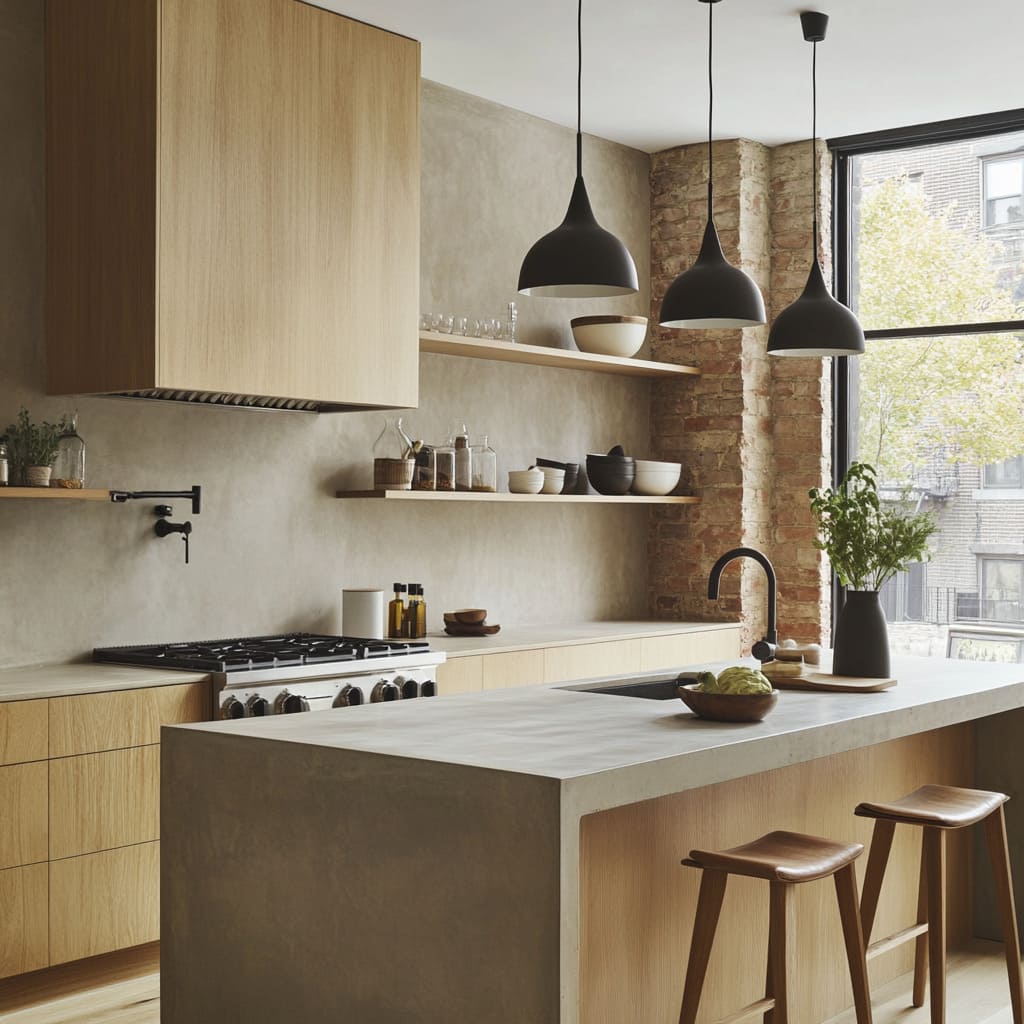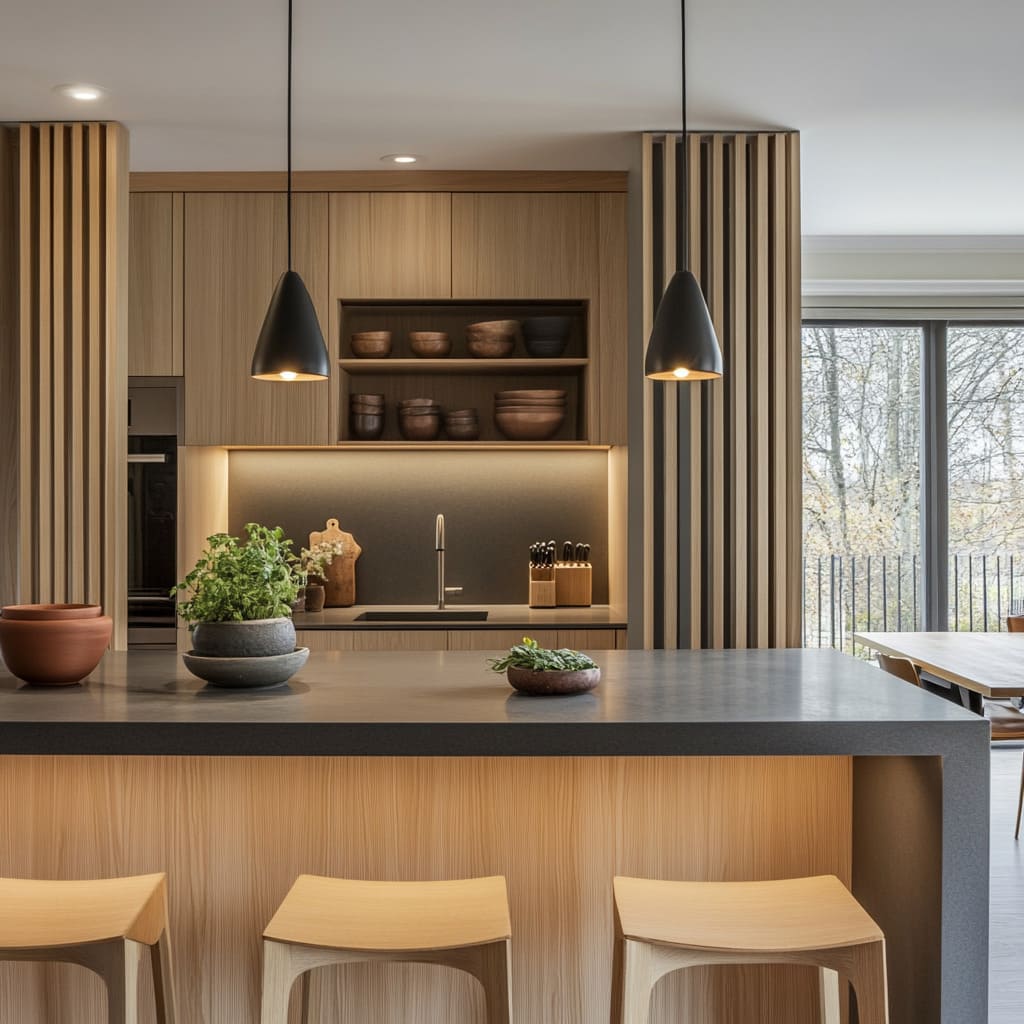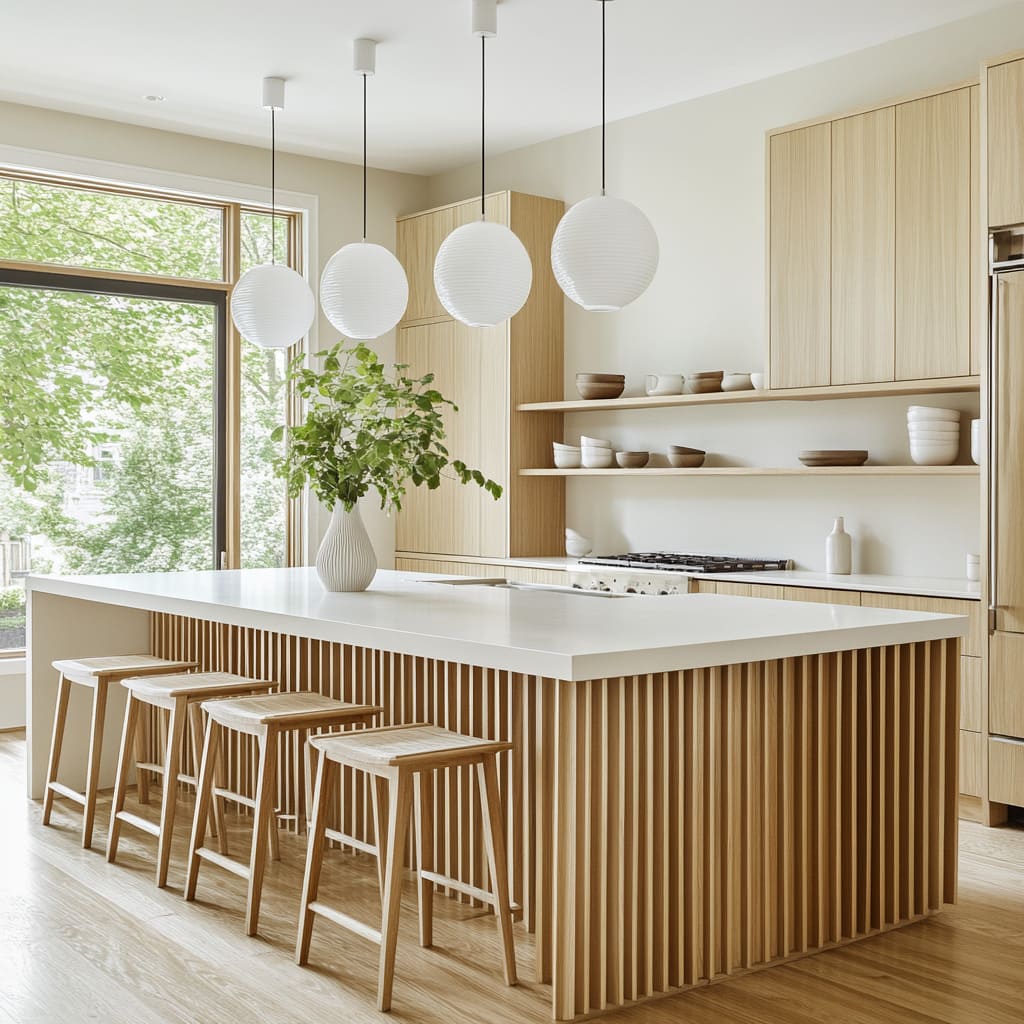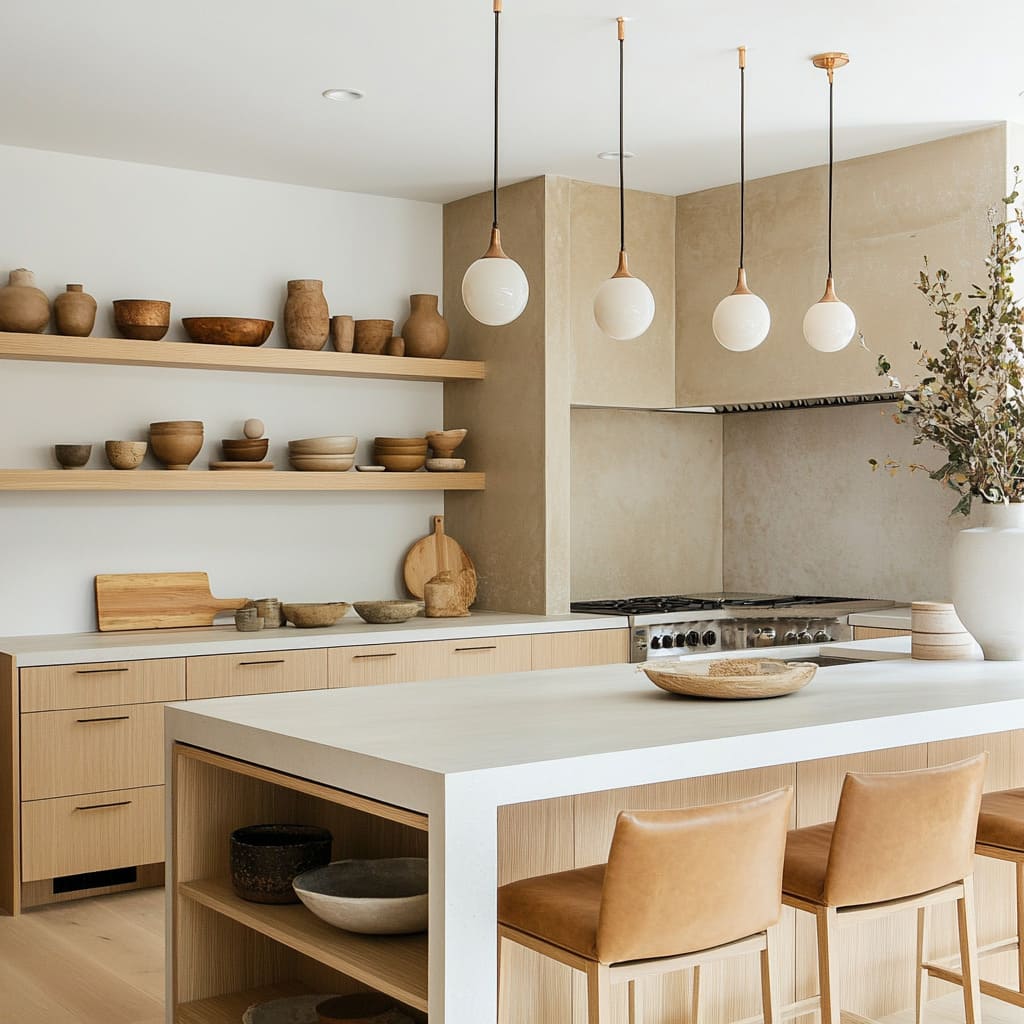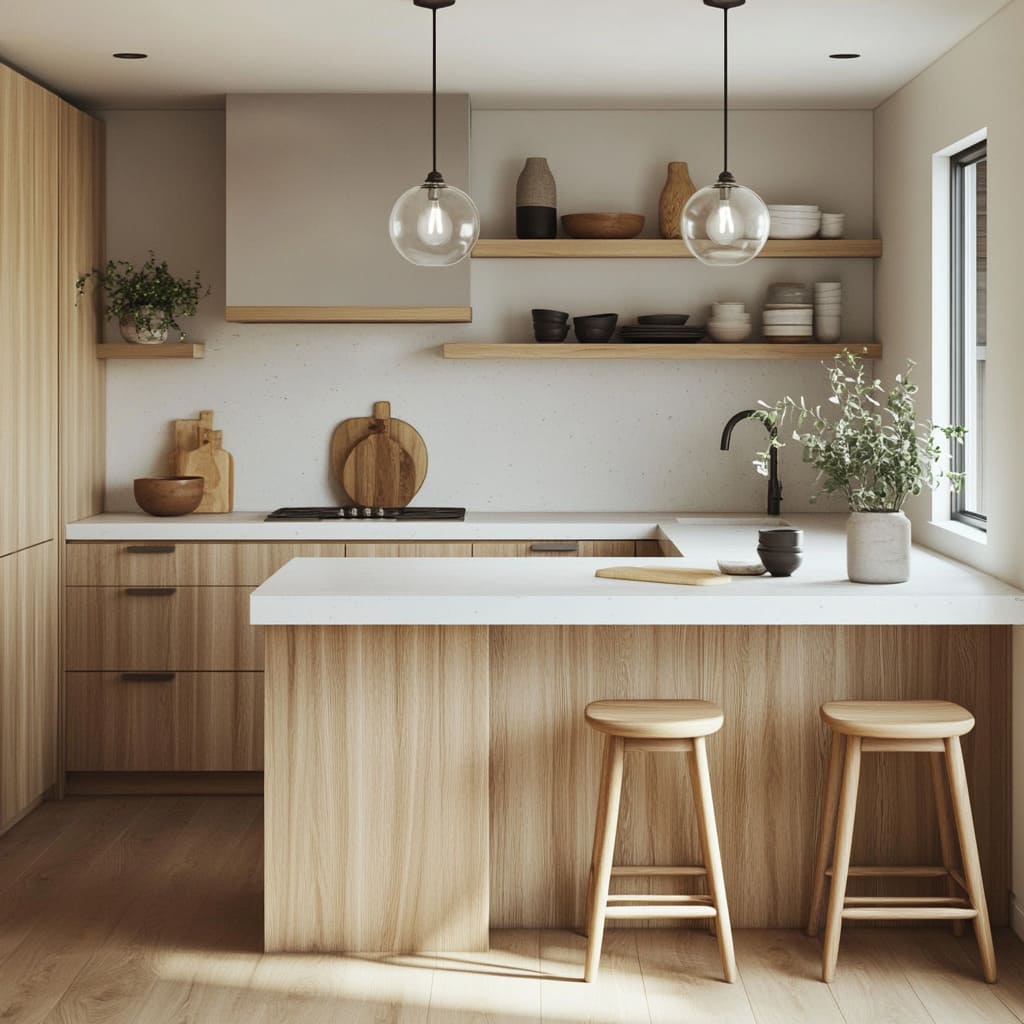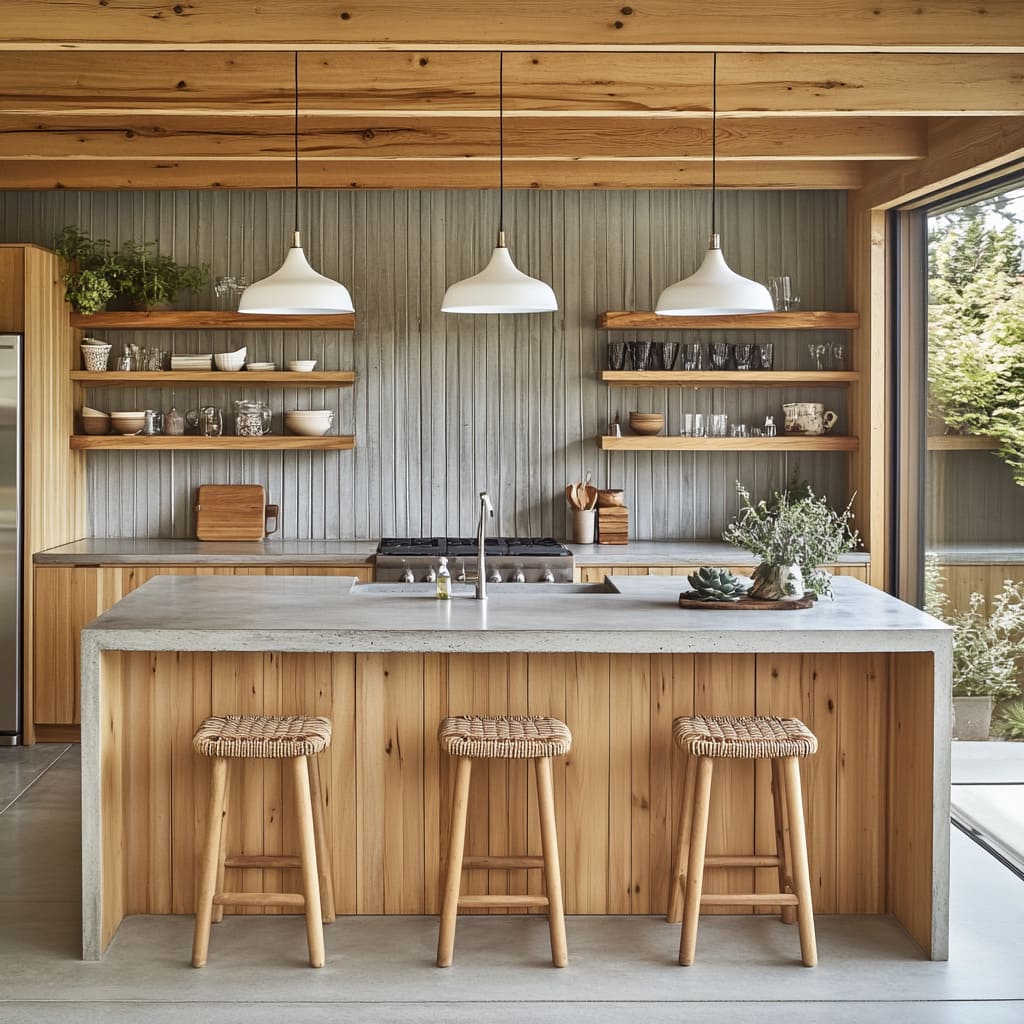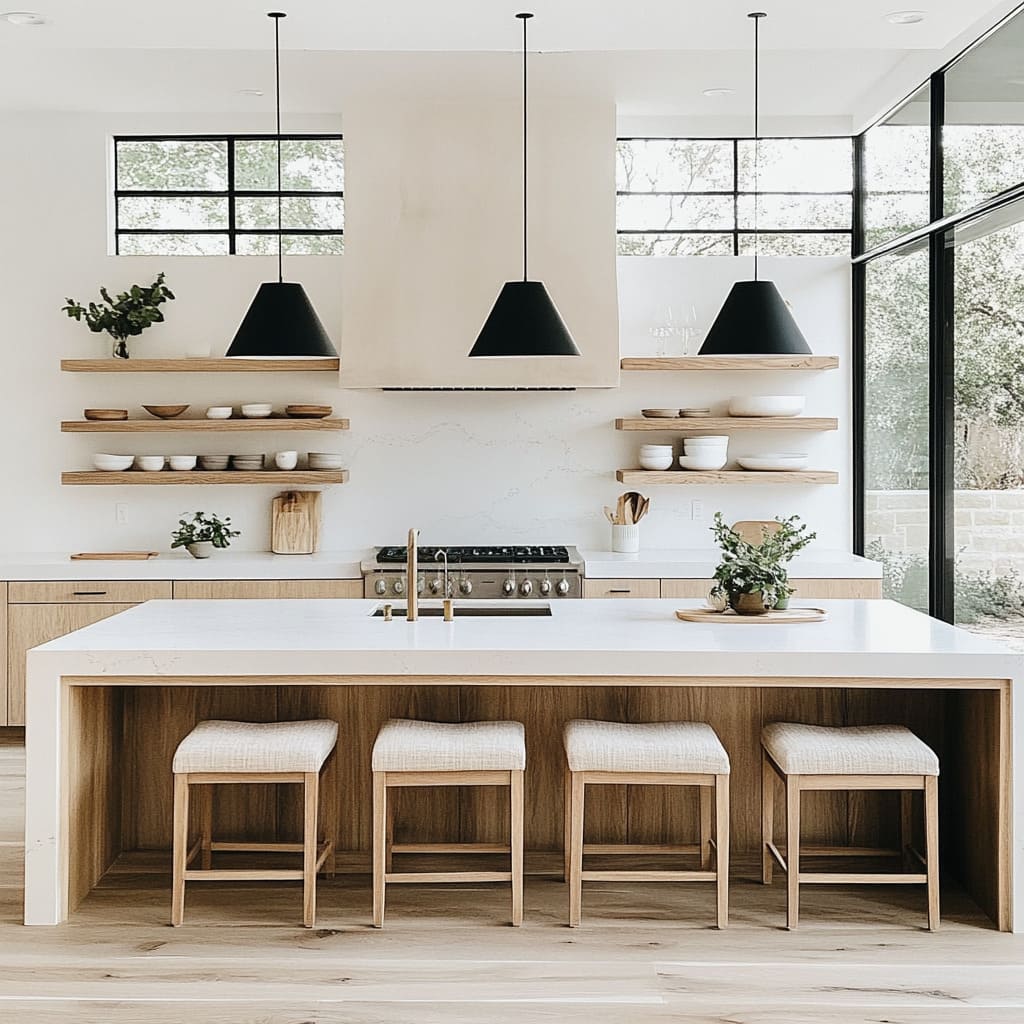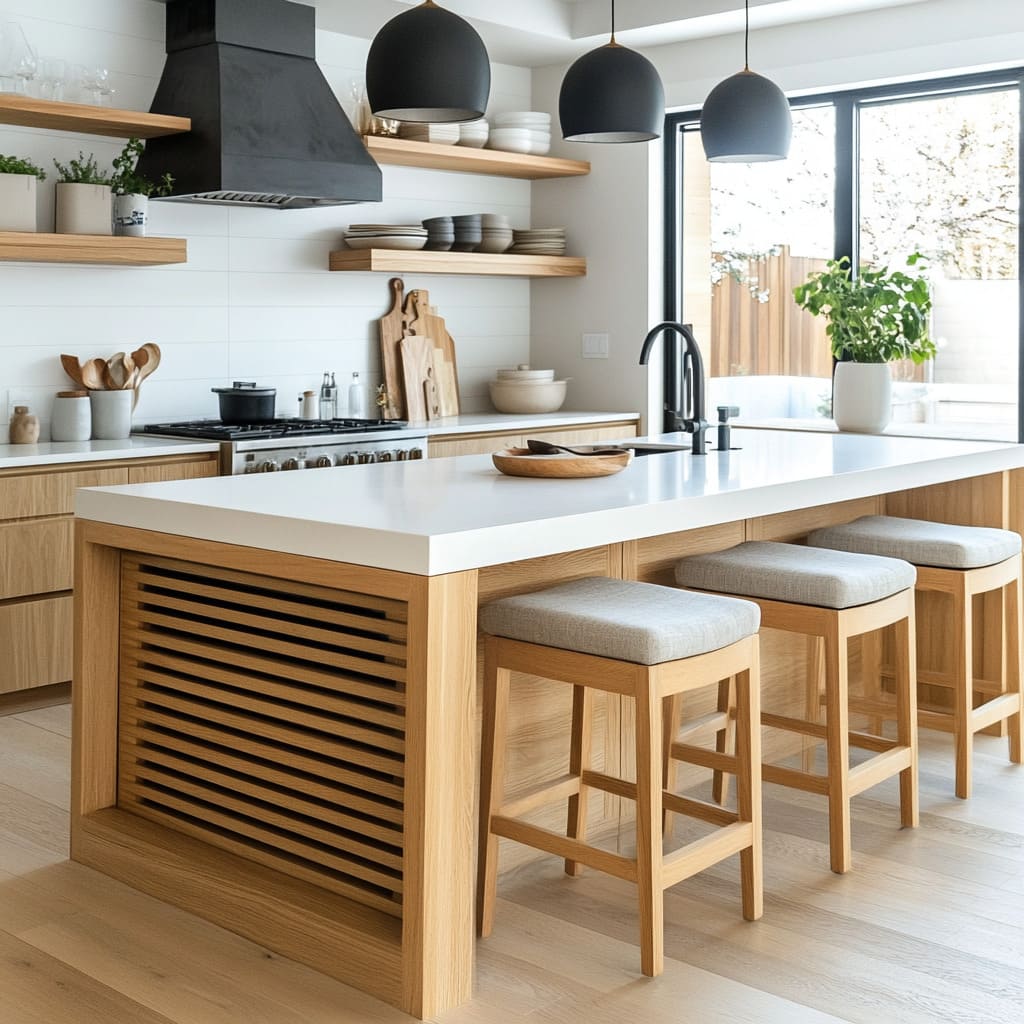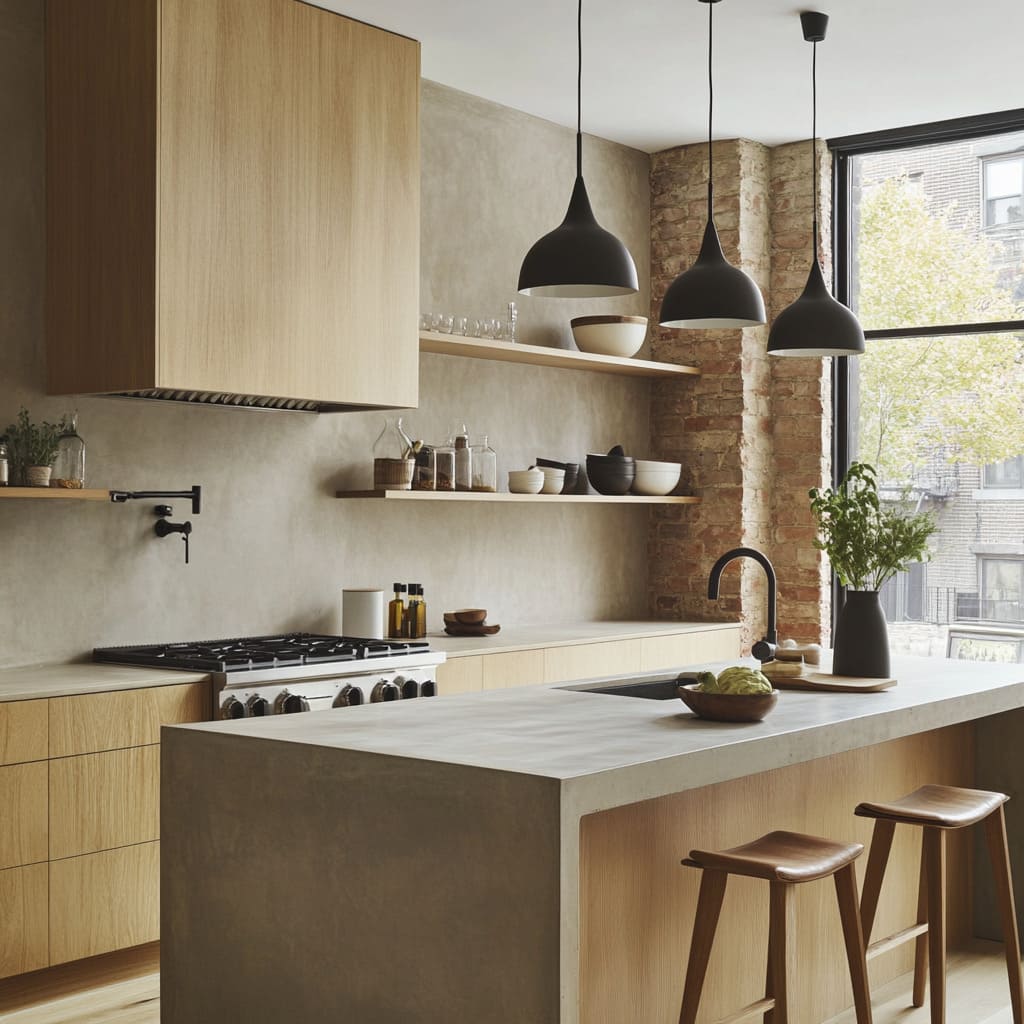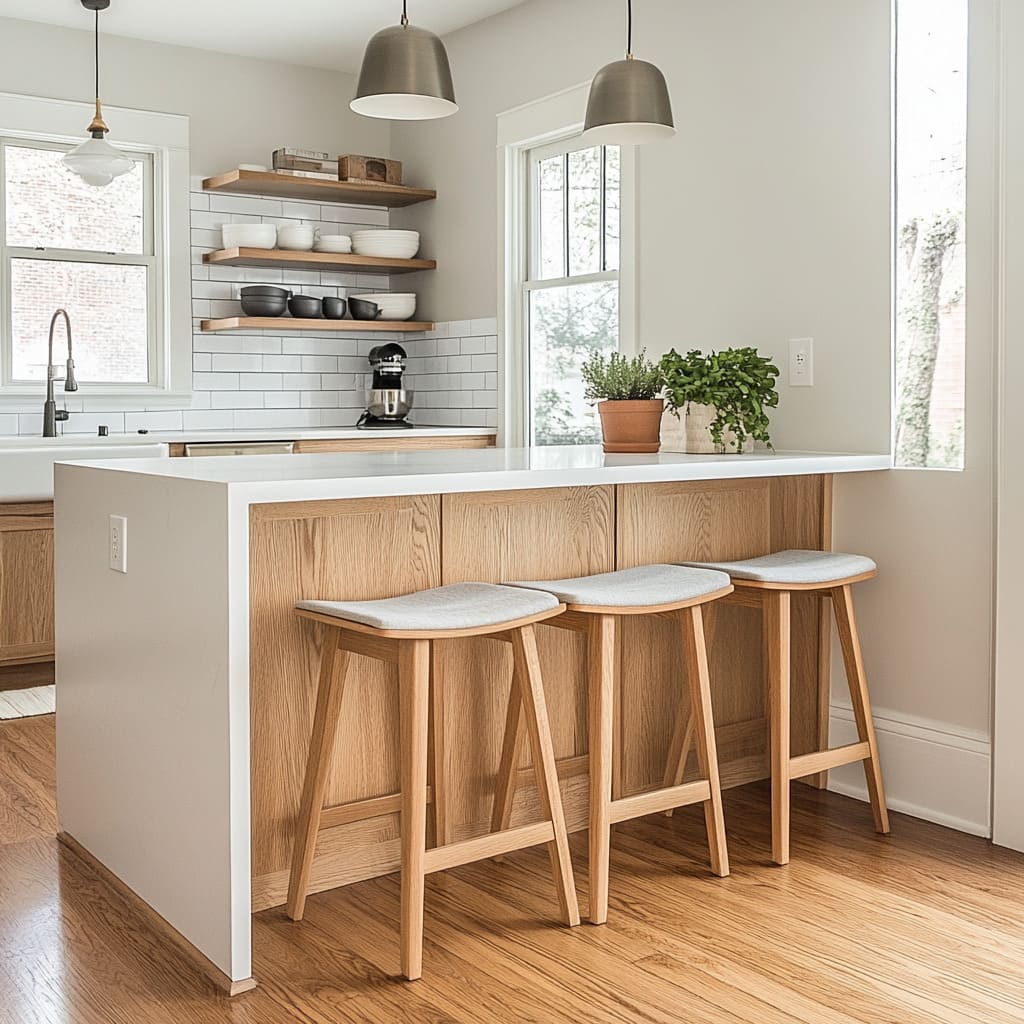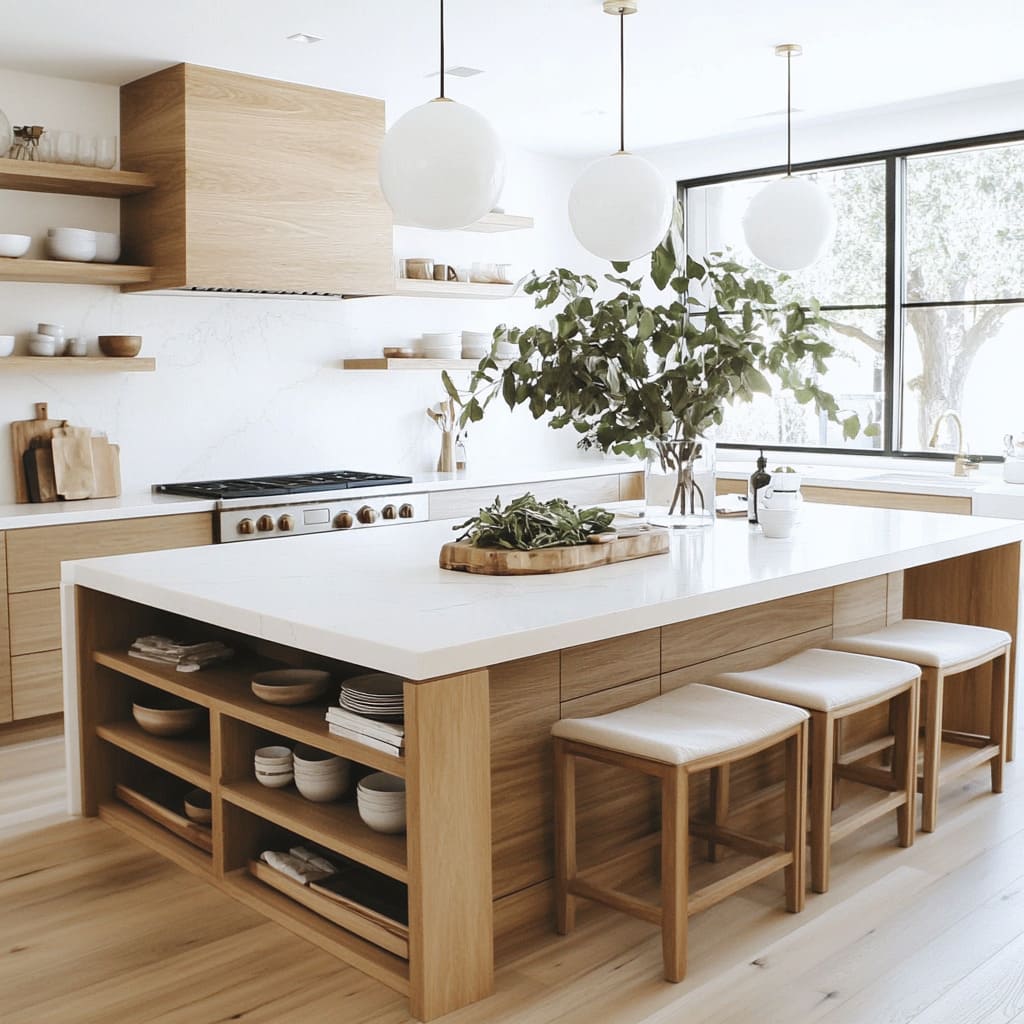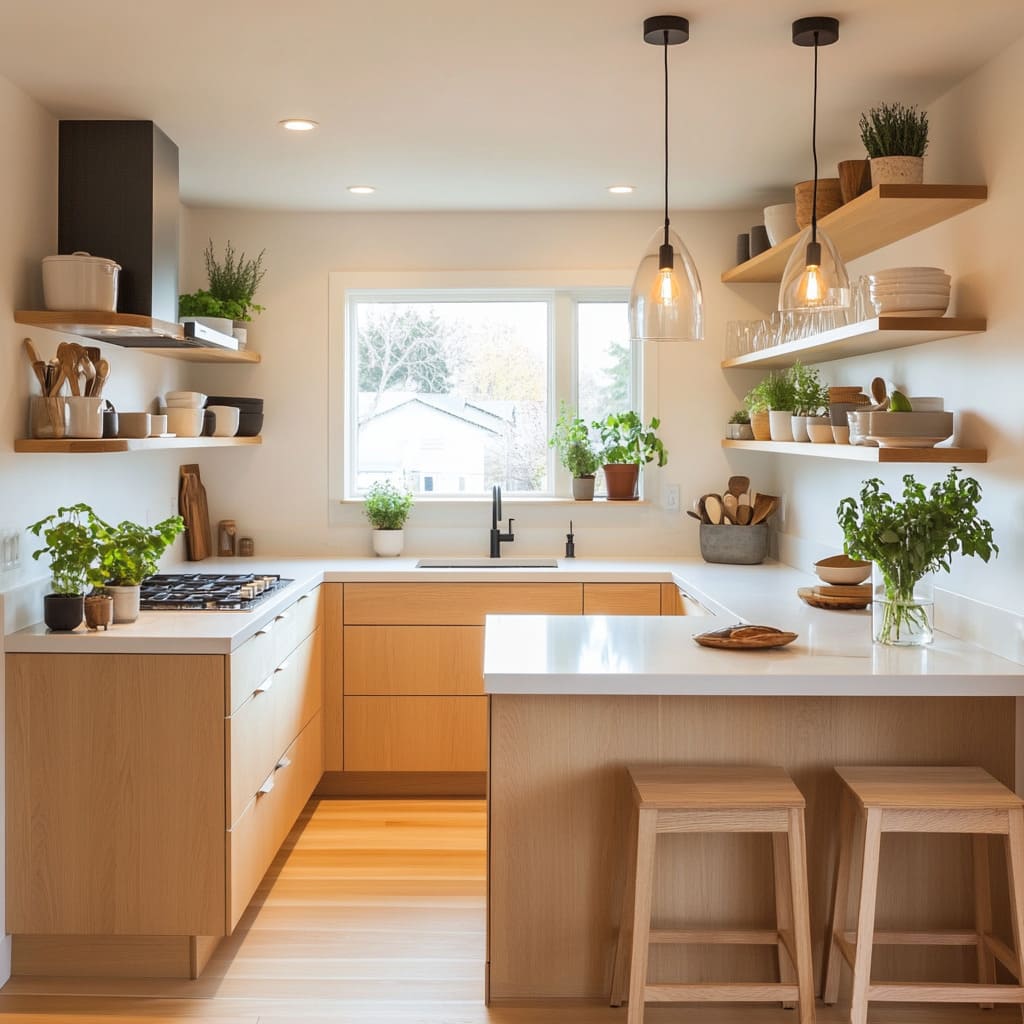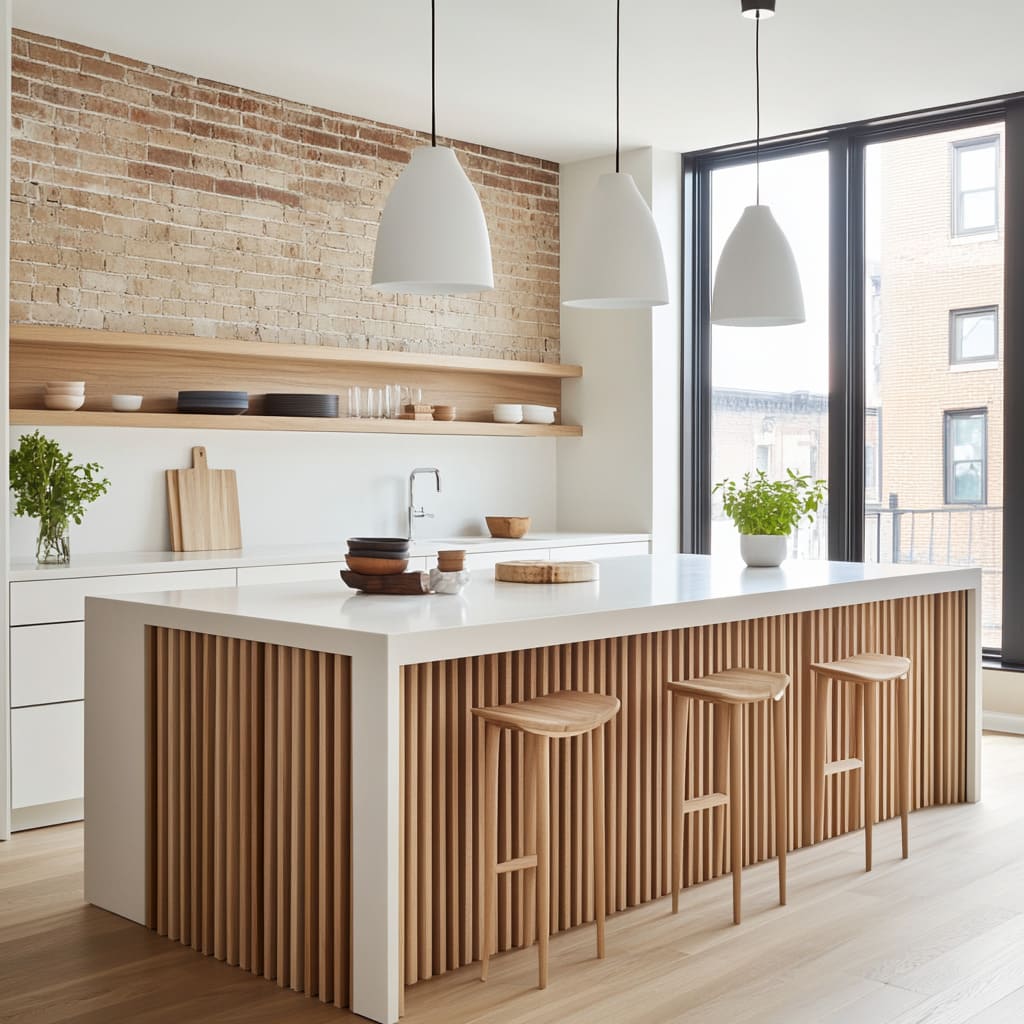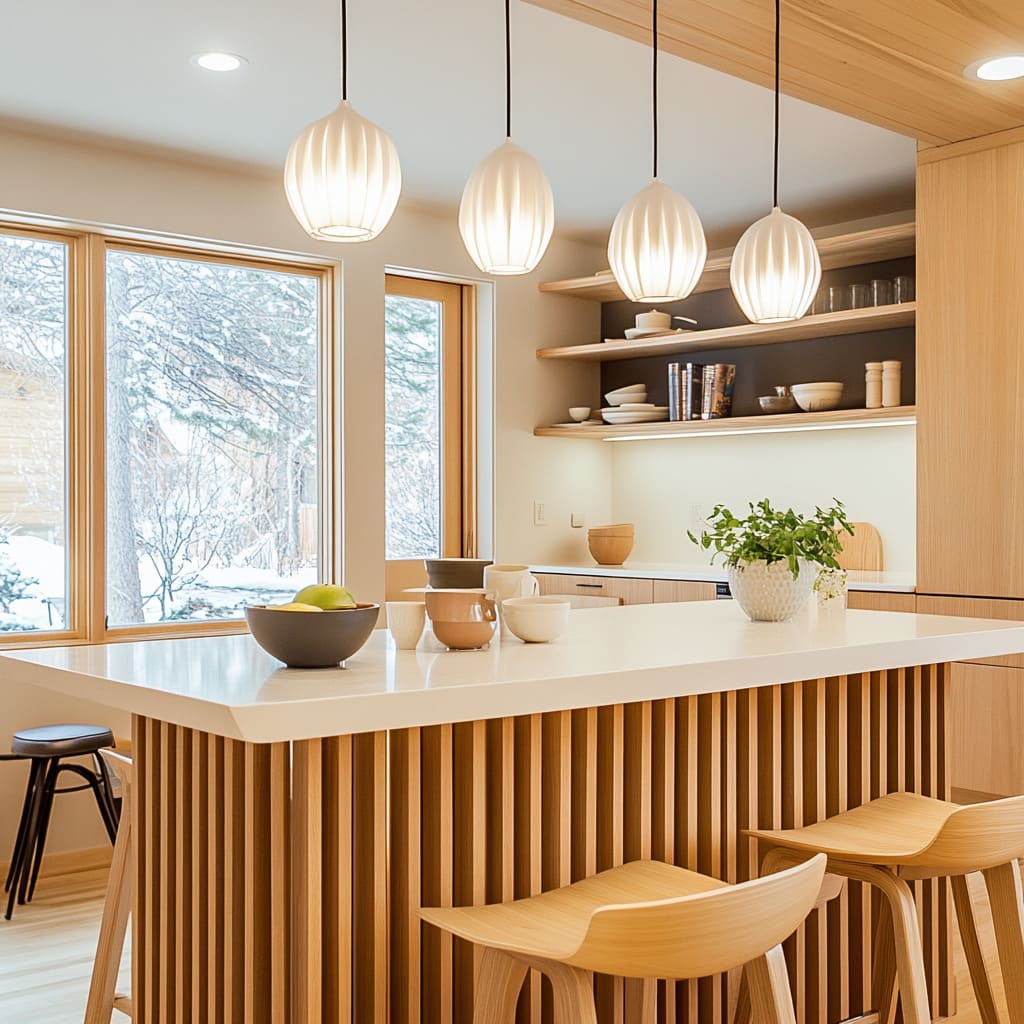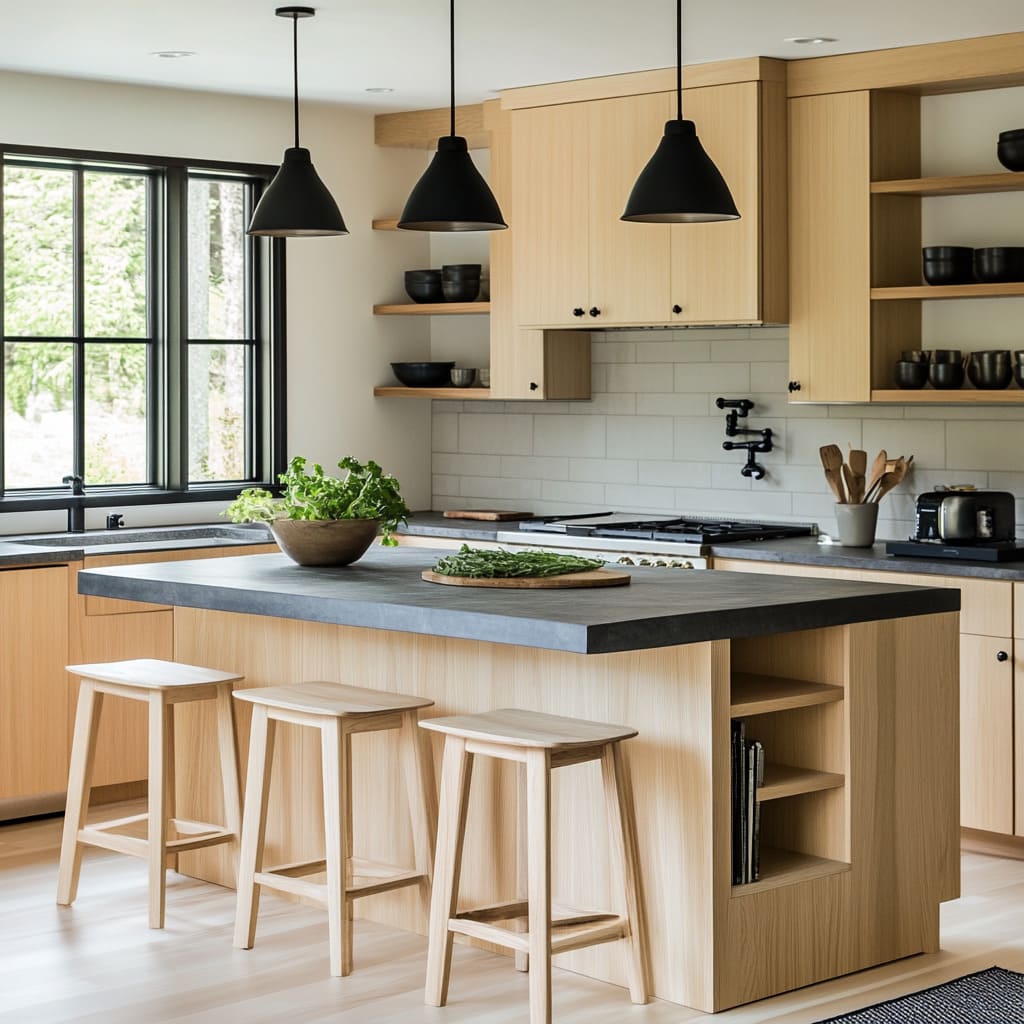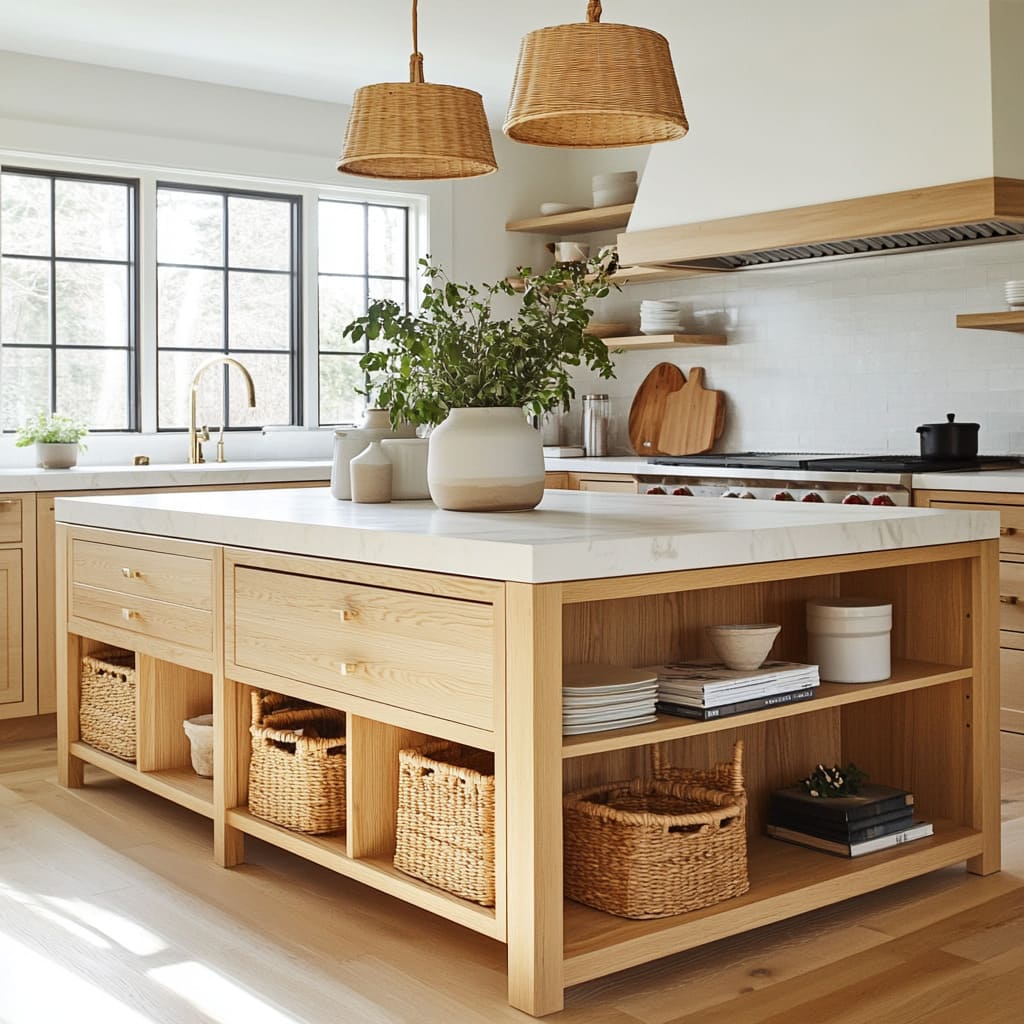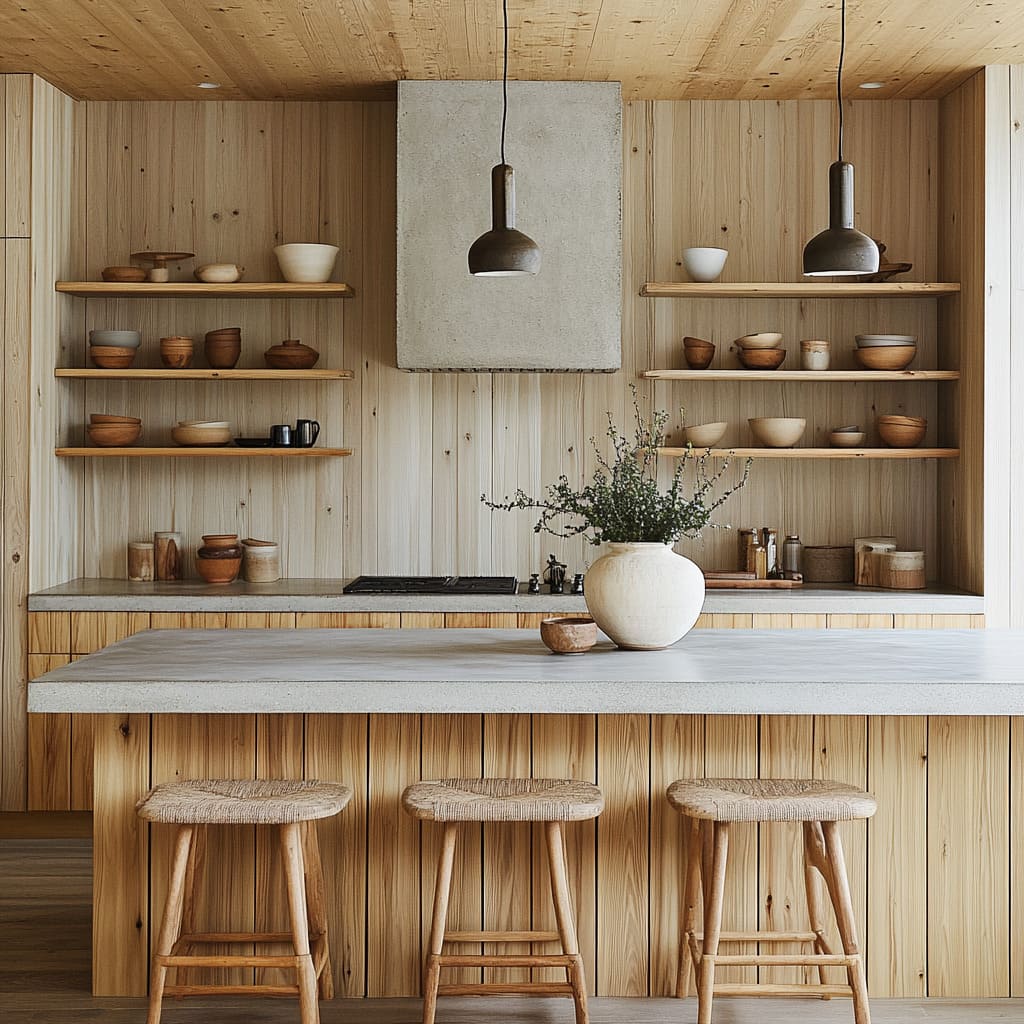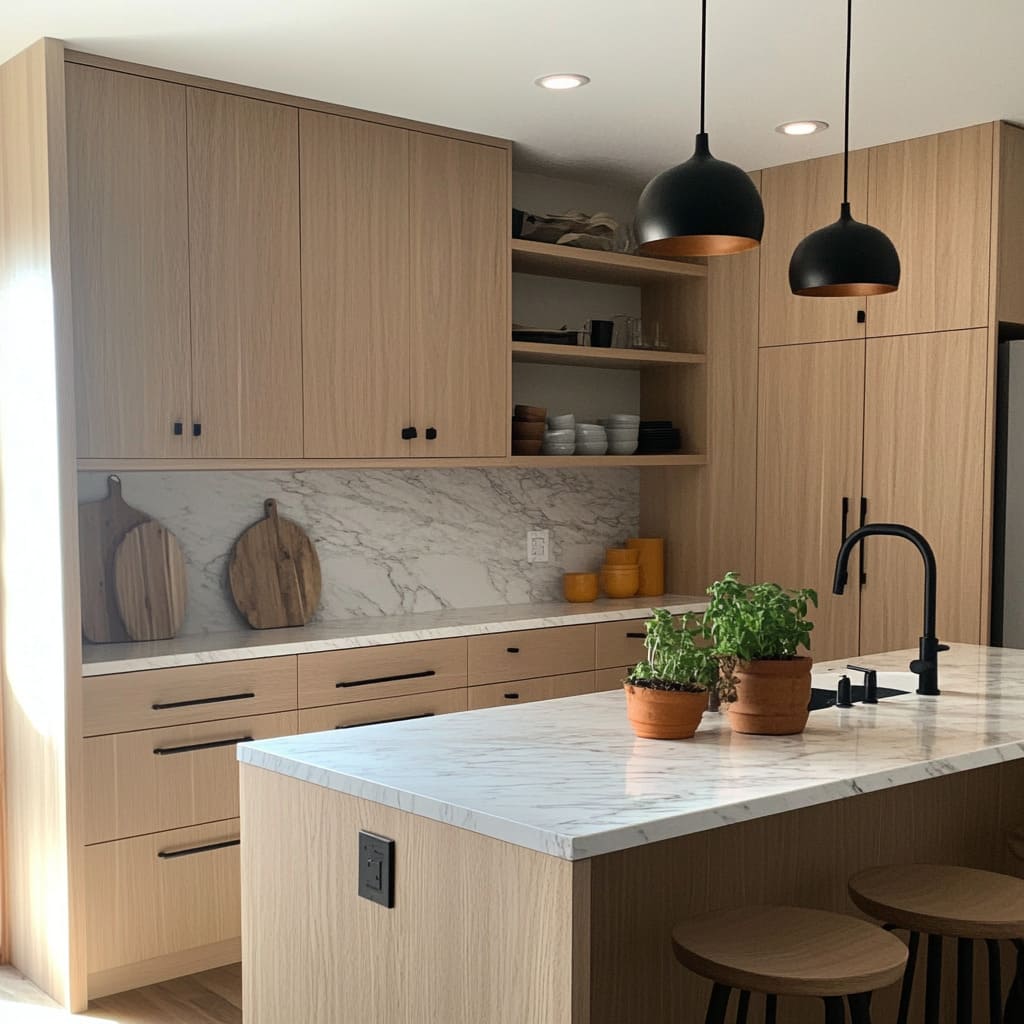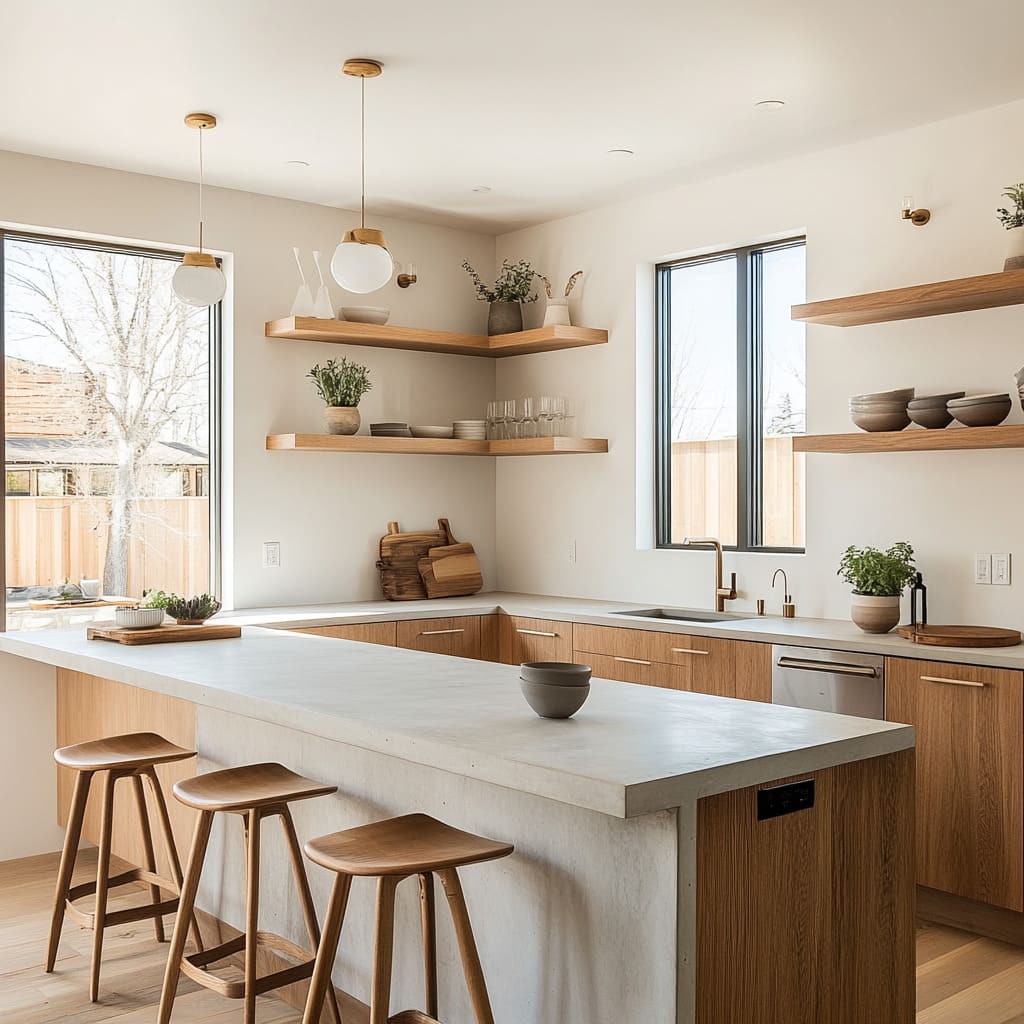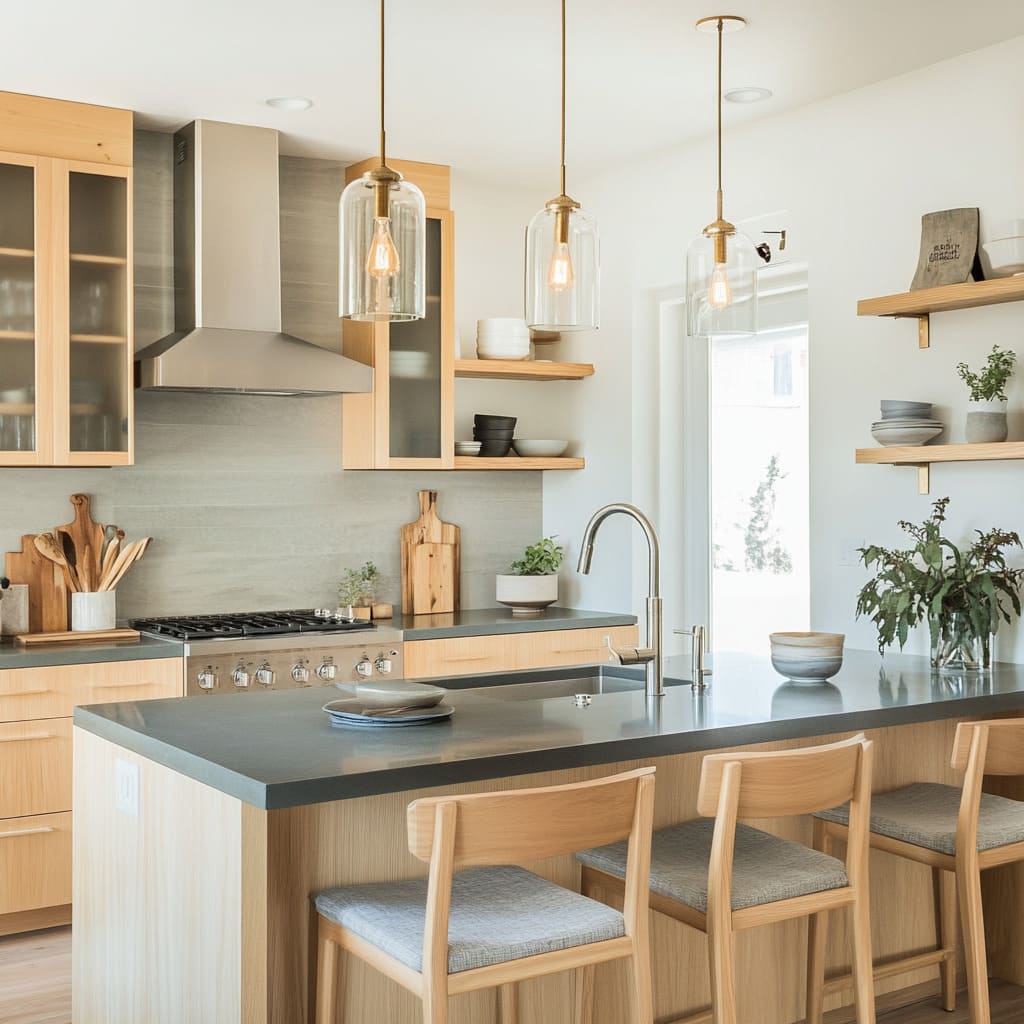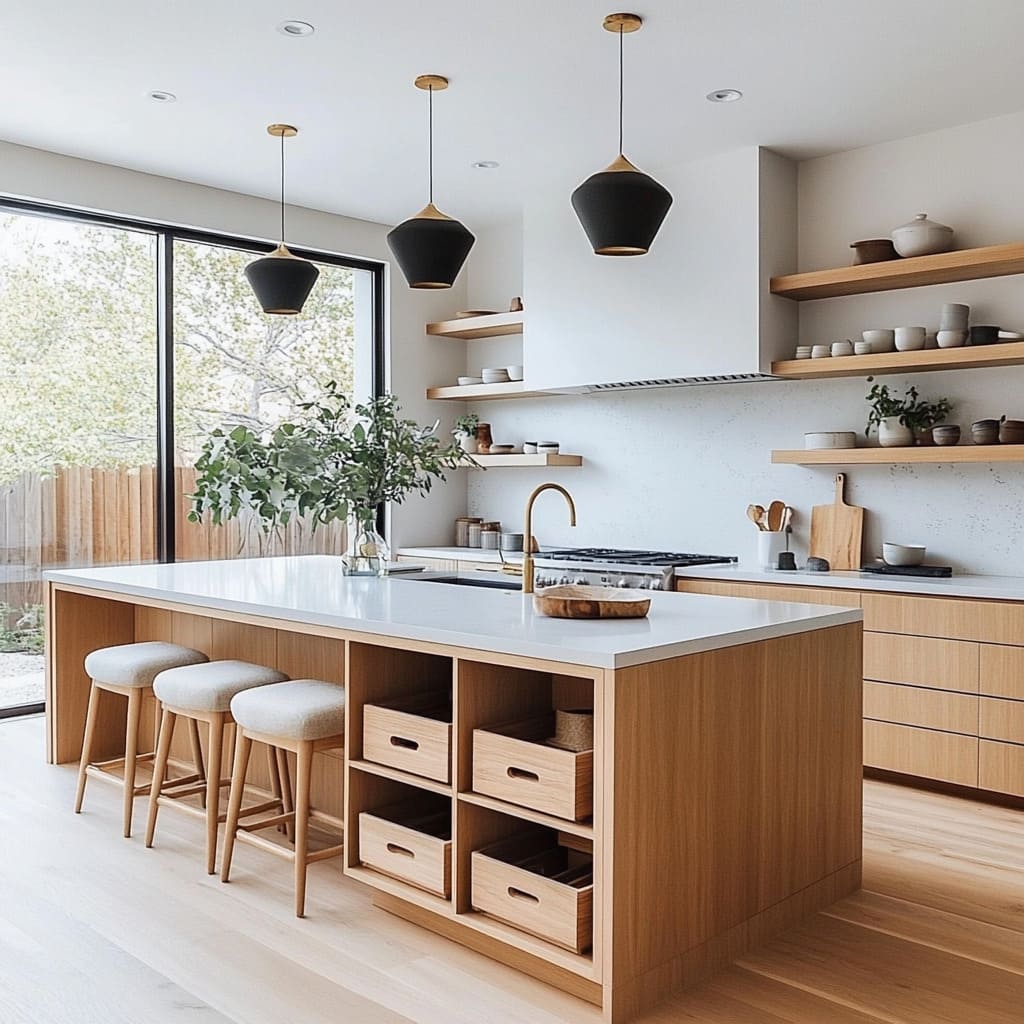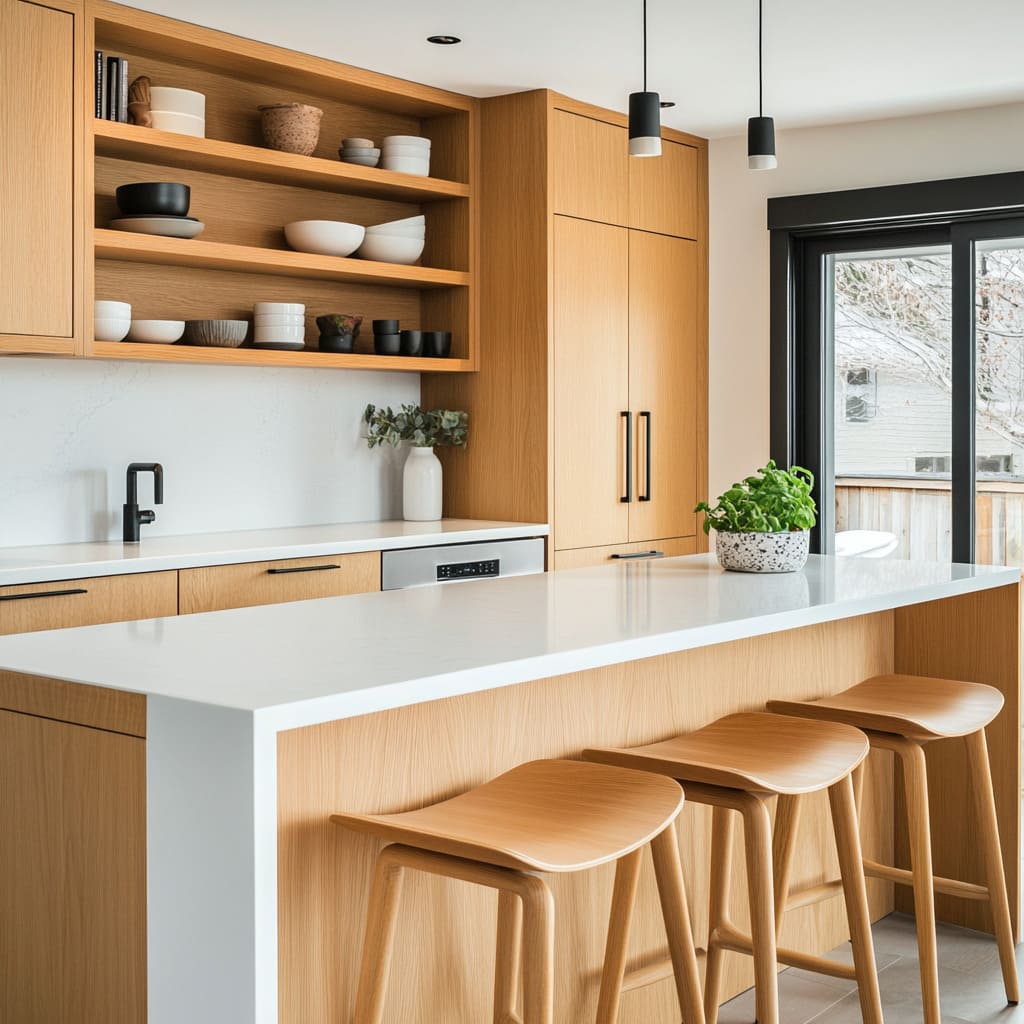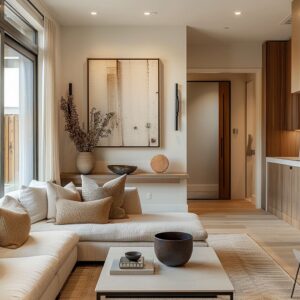Scandinavian kitchen design has gained popularity for its simplicity, natural materials, and relaxed atmosphere. It offers a clean, minimalist look that feels both inviting and functional, making it an excellent fit for American homes looking for a blend of comfort and style.
The focus on practicality means that every element in these kitchens serves a purpose without sacrificing aesthetics. At the heart of Scandinavian kitchen designs is the idea of reducing clutter and emphasizing functional beauty.
Clean lines, open spaces, and thoughtful design are key to ensuring the kitchen remains efficient for everyday tasks while still feeling spacious and welcoming. In fact, this balance between form and function is one of the defining traits that sets Scandinavian kitchens apart from other styles.
The simplicity of the design makes it easier to create a peaceful environment that doesn’t feel overwhelming. This guide will take you through the key elements that define a Scandinavian-style kitchen, offering tips and insights on how to achieve this look in your own home.
Whether you’re looking to add natural elements like wood and stone or want to incorporate minimalist storage solutions, this guide will show you how to create a space that is both stylish and practical.
Understanding Scandinavian Design Principles
Minimalism and Simplicity
One of the core principles of Scandinavian design is minimalism. The ‘less is more’ approach ensures that every piece in the kitchen has a purpose, and nothing unnecessary is included.
This helps create an open, airy environment that feels free of clutter. In a Scandinavian kitchen, the focus is on clean lines, seamless cabinetry, and furniture that doesn’t overpower the space.
Countertops are often kept clear, with only a few functional items like cutting boards, bowls, or planters placed as subtle decor. Simplicity doesn’t mean boring; instead, it allows you to showcase craftsmanship and materials, creating a kitchen that feels timeless.
Japandi kitchens, which blend Scandinavian and Japanese design principles, take this minimalism even further by integrating both function and art into the kitchen’s layout.
Use of Natural Materials
In Scandinavian kitchens, natural materials play a significant role in creating warmth and texture. Wood is often a key material used for cabinetry, shelving, and even flooring.
Common choices include oak, birch, ash, and beech, which bring a light and natural tone to the space. These woods are usually treated to maintain their natural look without excessive staining or varnish, helping the kitchen feel more connected to nature.
Stone is another common material, with marble, quartz, and even concrete used for countertops. These materials offer a cool contrast to the warmth of the wood, creating a balanced and harmonious design.
The combination of natural materials not only adds depth to the space but also ensures durability, making it practical for busy kitchens.
Neutral Color Palette
One of the most recognizable features of a Scandinavian-style kitchen is its neutral color palette. White walls, light wood tones, and soft grays dominate the space, helping to reflect natural light and make the room feel brighter and more open.
The goal is to create an atmosphere that feels calm and welcoming, where the colors are subtle but cohesive. While the base colors are often neutral, pops of color can be introduced through kitchen accessories, small plants, or simple ceramics displayed on open shelving.
This allows for some personal expression without overwhelming the minimalist aesthetic. The neutral backdrop also makes it easy to switch up decor or add seasonal touches without clashing with the overall design.
By understanding these core design principles, you can easily transform your kitchen into a Scandinavian-inspired space that feels both modern and timeless. Whether you’re leaning into the simplicity of Scandinavian kitchen designs or embracing natural materials, the result will be a kitchen that feels welcoming, functional, and perfectly suited to your home.
Choosing the Right Layout for a Scandinavian Kitchen
One of the defining features of a Scandinavian-inspired kitchen is the emphasis on openness and functionality. The layout plays a key role in achieving this, with many homeowners opting for open-concept designs that seamlessly link the kitchen to dining and living areas.
This approach fosters a cohesive flow, making the kitchen the heart of the home. The idea is to create a welcoming space where cooking, socializing, and dining naturally blend together.
Open-Concept Design
Open-concept layouts are incredibly popular in Scandinavian kitchen design because they encourage a sense of spaciousness and light. In American homes, where the kitchen is often a hub for family gatherings, this design approach works beautifully.
It removes barriers between the kitchen, dining, and living spaces, allowing everyone to feel connected. The result is a free-flowing environment that’s perfect for entertaining or simply enjoying time with family.
This type of layout also helps to make the kitchen feel larger, even in smaller homes. By eliminating walls, natural light can travel more freely, enhancing the airy, uncluttered vibe typical of a modern Scandinavian kitchen.
Common Layouts
Peninsula Kitchens: For those with smaller or medium-sized kitchens, a peninsula layout is an ideal choice. Peninsulas offer a smooth transition between the kitchen and the adjacent dining or living area, without taking up as much space as an island.
This layout works particularly well in a small Scandinavian kitchen, where maximizing every square inch is key. A peninsula can serve as both a functional prep area and an informal dining space, making it an excellent solution for homes where space is limited.
Central Islands: In larger kitchens, a central island is often the preferred layout. A kitchen island not only provides ample work surface but also doubles as a casual dining area or a spot for guests to gather while you cook.
The island serves as a central hub, keeping everything—cooking, prepping, and socializing—within easy reach. It’s especially useful in open-concept designs where the kitchen needs to flow smoothly into the surrounding spaces.
A well-designed island can elevate both the aesthetics and functionality of a modern Scandinavian kitchen.
Functional Flow
Another crucial aspect of a Scandinavian kitchen layout is the emphasis on easy movement between different zones. The kitchen should allow for an effortless transition from prepping to cooking and then to dining.
This is where the Scandinavian design’s functional beauty comes into play. Everything, from storage solutions to appliance placement, is designed to enhance workflow, making the space feel intuitively organized.
Selecting Cabinetry and Countertops
Cabinetry and countertops are foundational elements in any kitchen, and Scandinavian designs emphasize natural materials and clean lines to create a warm, minimalist atmosphere.
Natural Wood Cabinetry
Scandinavian kitchens frequently use light woods such as ash, oak, birch, and beech to create a cozy, natural feel. The pale tones of these woods brighten up the kitchen, making it feel more spacious and inviting.
These natural wood finishes, often left unstained or only lightly treated, emphasize the organic qualities of the material while creating a backdrop that is both functional and beautiful. For homeowners who want to bring a touch of nature indoors, wood cabinetry is a perfect solution.
Incorporating wood into the cabinetry also helps the kitchen blend seamlessly with other rooms, especially in open-concept layouts. This consistent use of natural materials reinforces the sense of flow between different areas of the home.
Flat-Panel and Slatted Designs
Scandi kitchen ideas typically favor simple, flat-panel cabinetry for a sleek, understated look. These smooth, uninterrupted surfaces create a clean aesthetic and are easy to maintain.
In some designs, vertical or horizontal slats add texture and interest without overwhelming the minimalist style. This subtle detailing can make a big impact, providing visual depth while maintaining the overall simplicity that defines the Scandinavian approach.
Countertop Materials
When it comes to countertops, materials like white quartz, marble, and polished concrete are common choices. These materials offer a cool, smooth contrast to the warm wood cabinetry, creating a balanced and harmonious look.
Quartz is particularly popular for its durability and low maintenance, while marble adds a touch of luxury. Concrete countertops bring an industrial edge that complements the minimalist lines of Scandinavian design.
The combination of these materials with wood cabinetry helps achieve the perfect blend of natural warmth and modern sleekness.
Soft-Close Mechanisms
Practicality is a hallmark of Scandinavian kitchens, and soft-close drawers and cabinets are a small but significant feature that enhances everyday functionality. These mechanisms ensure that drawers close gently and quietly, preventing wear and tear over time.
Not only do they improve the user experience, but they also maintain the clean, minimalist aesthetic by reducing noise and avoiding slamming cabinets.
Integrating a Kitchen Island or Peninsula
In Scandinavian kitchens, the island or peninsula often serves as the focal point, offering both functional workspaces and social areas.
Design and Function
A well-designed kitchen island or peninsula serves as a multi-purpose space, providing an area for prepping meals, storing kitchen tools, and gathering with family or friends. The simplicity of Scandinavian design shines through here, with a focus on both practicality and understated beauty.
In smaller homes, a peninsula can offer just as much function as an island, while fitting more easily into compact spaces. These elements are central hubs in Scandinavian kitchens, offering plenty of room for cooking and socializing alike.
Extending Countertops
One clever design feature often seen in Scandinavian-inspired kitchens is the use of extended countertops. By allowing the countertop to extend outward slightly, you create a casual dining area or breakfast bar without the need for additional furniture.
This feature makes the most of the available space, especially in smaller kitchens, where maximizing functionality is key.
Storage Solutions
Storage in Scandinavian kitchens is always thoughtfully planned. Built-in storage options like pull-out drawers, spice trays, or recycling bins are seamlessly integrated into the island or peninsula, ensuring that everything has its place.
These smart storage ideas help keep countertops clutter-free while making it easy to access essentials during cooking. The goal is always to make the kitchen work efficiently without sacrificing the clean, streamlined look.
Shelving Options
In addition to storage, open shelving on the front or side of an island can be a stylish way to display simple ceramics, small plants, or other decorative items. This creates a sense of openness and adds a personal touch to the design.
The natural materials and neutral tones of Scandinavian kitchens pair well with understated decor, allowing you to add personality without disrupting the clean lines of the space.
Lighting Your Scandinavian Kitchen
Lighting is an essential element in Scandinavian kitchen interior design. Not only does it provide functional illumination for cooking and dining, but it also plays a key role in shaping the overall mood of the space.
Pendant lighting, in particular, is a defining feature in Scandinavian kitchens, acting as both a practical source of light and a focal point that enhances the kitchen’s aesthetic.
Pendant Lighting
In Scandinavian kitchens, pendant lights are often placed above islands or peninsulas, where they provide a soft, ambient glow that enhances the warm, inviting atmosphere typical of this style. These lights not only serve a practical purpose but also add a touch of personality to the space.
The simple, clean lines of the pendants complement the minimalist design of the kitchen while drawing attention to key areas like the modern kitchen Scandinavian island. Pendant lighting also helps create zones within the kitchen, distinguishing areas for prep work, dining, or socializing.
By focusing light where it’s needed most, pendants contribute to a well-organized and efficient kitchen environment.
Material and Design Choices
Scandinavian design emphasizes natural materials and understated elegance, and this is reflected in the choice of lighting fixtures. Popular options include matte black metal, white ceramic shades, and brass accents, which add a modern touch without overpowering the minimalist aesthetic.
Frosted or clear glass pendants are also common, providing a soft glow that enhances the room’s warmth and open feel. When selecting pendant lights, think about how the materials will complement other elements in the kitchen.
For example, matte black lights can add a sleek, contemporary contrast to light wood cabinetry, while brass accents bring a subtle warmth that pairs well with neutral tones.
Placement and Grouping
When it comes to placement, pendant lights are often hung in groups of two or three above a kitchen island or peninsula. This not only ensures even lighting but also creates a visually balanced arrangement.
The key is to space them out evenly to maintain a sense of proportion while allowing each light to shine on its own. For an island or a longer peninsula, grouping multiple pendants adds depth and interest, while still keeping the design cohesive.
Each pendant should hang low enough to provide ample light but high enough to avoid obstructing the view, allowing for easy movement and interaction across the kitchen space.
Adding Seating with Scandinavian Style
Seating in a Scandinavian kitchen is all about comfort and simplicity. The choice of stools or chairs plays a significant role in how the space functions and feels.
Whether your kitchen has an island or a peninsula, selecting the right seating adds the perfect finishing touch.
Choosing the Right Stools
Wooden stools with woven seats are a popular choice in minimalist Scandinavian kitchen design, as they provide both texture and a nod to natural materials. The light tones of ash or oak stools blend seamlessly with the overall Scandinavian aesthetic, offering a clean and organic look.
For those who prefer a more modern edge, leather-upholstered stools add a subtle touch of luxury without overwhelming the space. Backless stools are another excellent option, as they maintain the clean lines typical of Scandinavian design while allowing for easy movement around the kitchen.
Backless designs are particularly useful in smaller spaces, where they can be tucked neatly under the island or peninsula when not in use.
Comfort Meets Style
While Scandinavian design is known for its simplicity, comfort is never sacrificed. Stools with cushioned seats or low backs provide extra support for long meals or casual gatherings, making the kitchen feel more inviting.
The goal is to balance style with comfort, ensuring that the seating complements the minimalist design while still offering a cozy place to sit. Incorporating stools that feature soft, neutral fabrics or simple woven textures adds warmth to the room.
The combination of sleek, modern shapes with comfortable seating creates a kitchen that feels practical yet welcoming—just what you’d expect from Scandinavian kitchen inspiration.
Incorporating Functional Storage Solutions
Scandinavian kitchens are admired for their ability to blend form and function seamlessly, and storage is one area where this balance really shines. Clever storage solutions keep the space organized and clutter-free while maintaining the minimalist aesthetic that defines modern Scandinavian kitchen design.
Smart Storage Ideas
One of the best aspects of Scandinavian kitchens is their commitment to functionality. Pull-out racks for spices, deep drawers for pots and pans, and vertical dividers for baking sheets are just a few of the smart storage solutions that make these kitchens so practical.
Everything has its place, and every inch of space is used efficiently, ensuring that the kitchen remains organized without feeling cramped. Built-in storage compartments can be added to kitchen islands or peninsulas, making them even more functional.
These solutions make it easy to keep everyday items within reach while preserving the clean lines of the kitchen.
Hidden Storage
Concealed storage is another hallmark of Scandinavian kitchen inspiration. Pull-out bins for pantry items or recycling are often tucked away behind sleek cabinet doors, ensuring that the kitchen maintains its streamlined appearance.
These hidden solutions help keep clutter out of sight, reinforcing the minimalist vibe while still providing plenty of storage for the essentials. The idea is to create a kitchen that works for everyday life without compromising the design.
Hidden storage allows for a clutter-free environment while ensuring that everything you need is easily accessible.
Open Shelving and Display Niches
Open shelving is a great way to add a personal touch to a Scandinavian kitchen without disrupting its simplicity. Small cubbies or open shelves can be used to display cookbooks, neutral-toned ceramics, or even potted plants, adding character and warmth to the space.
These decorative touches allow for a bit of self-expression while maintaining the overall minimalist feel. When using open shelving, it’s important to avoid overcrowding the space.
Stick to a few carefully chosen items, such as a set of handmade pottery or a simple row of glasses, to create a visually appealing display that enhances the kitchen’s clean lines. By incorporating these functional storage solutions, you can create a kitchen that is not only beautiful but also efficient, reflecting the true essence of Scandinavian design.
Decorating with Scandinavian Touches
Decorating a Scandinavian kitchen is all about enhancing the natural, minimalist design without cluttering the space. A few carefully chosen decor pieces can create a welcoming atmosphere, adding warmth and a personal touch to the clean lines and neutral tones that define this style.
Natural and Simple Decor
Incorporating elements from nature is a cornerstone of Scandinavian kitchen interior design. Small potted plants, herbs, and neutral-colored ceramic vases bring a fresh, organic feel to the room.
Consider placing a few potted herbs on an open shelf or windowsill, not only for decoration but for easy access when cooking. The presence of greenery adds life to the space, breaking up the neutral color palette while still keeping things understated.
Neutral ceramics, such as simple vases in soft tones, can be arranged on open shelving or countertops to add interest without overwhelming the minimalist look. These pieces should be subtle, serving as accents that enhance the overall design rather than competing with it.
A few well-chosen items are all it takes to maintain the balance of simplicity and style.
Personal Touches
A Scandinavian minimalist kitchen doesn’t have to feel sterile—adding personal touches is a great way to create a sense of comfort and individuality. Handmade or artisanal decor items, like clay vases or hand-thrown pottery, can add a rustic feel while still aligning with the natural materials commonly used in Scandinavian interiors.
Simple glassware, especially when displayed on open shelving, adds a practical yet decorative element that ties in well with the clean lines of the overall design. These personal additions keep the kitchen cozy and welcoming without straying from the minimalist aesthetic.
Think of them as small statements that quietly complement the room’s design. For example, a wooden cutting board placed against a wall, or a delicate ceramic bowl on the countertop, can enhance the space without adding visual clutter.
Maintaining Minimalism
The key to decorating a Scandinavian kitchen is to avoid overloading the space with too many decorative items. It’s important to style the decor in a way that keeps things light and uncluttered.
Less is always more when it comes to wood Scandinavian kitchen design. Choose just a few decor pieces to display at any given time, and ensure that they are well-spaced to keep the open, airy feel of the room.
A good tip is to rotate decor items seasonally or change them up periodically to keep things fresh without adding unnecessary bulk. When arranging decor, aim for symmetry or balance.
For instance, one vase on an open shelf or a pair of matching pots creates visual harmony without breaking the minimalist tone of the room. Decorative elements should be functional or have a strong connection to the overall design.
Final Tips for Creating a Scandinavian-Style Kitchen
Bringing together all the elements of a Scandinavian kitchen requires thoughtful planning to ensure the space feels both cohesive and practical. Here are a few final tips to keep in mind.
Focus on Cohesion
One of the most important aspects of a Scandinavian kitchen is the sense of unity. Whether it’s matching the wood tones in the cabinetry and furniture or choosing lighting fixtures that complement the overall style, cohesion ties the whole look together.
Consistency in material and color selection helps maintain the clean, minimalist feel that is central to Scandinavian design. When selecting pieces, think of how they work as part of the larger picture, ensuring they complement rather than contrast the overall aesthetic.
For example, when using a light oak for cabinetry, choose stools or open shelving that feature similar tones to keep the design seamless. This creates a Scandinavian minimalist kitchen look that feels well thought out and polished without seeming overdone.
Experiment with Textures
Even in minimalist designs, it’s possible to create visual interest by experimenting with textures. Mixing materials like matte metals, woven fabrics, and polished stone can add depth and richness to the space.
For example, sleek marble countertops can be paired with wooden cabinetry for contrast, while matte black metal hardware adds a modern touch. Woven seats on stools or fabric cushions in soft, neutral tones can provide warmth and comfort while keeping the kitchen grounded in Scandinavian principles.
The interplay of textures should remain subtle, with no single material dominating the space, but rather contributing to a harmonious blend.
Practical and Aesthetic Balance
A Scandinavian kitchen isn’t just about how it looks—it’s about how it functions. Balancing practicality with aesthetics is crucial to achieving an authentic Scandinavian-inspired kitchen.
Smart storage solutions such as pull-out drawers, built-in bins, and strategically placed shelving make the kitchen efficient while preserving its minimalist charm.
Remember that functionality enhances the beauty of a Scandinavian kitchen. Every element, from lighting to storage, should serve a purpose.
Whether you’re placing decor on open shelving or arranging kitchen utensils, it’s all about creating a space that works for everyday life while still looking simple and elegant. By striking this balance, you’ll have a kitchen that’s not only beautiful but also practical, capturing the true essence of Scandinavian design.
Conclusion
Scandinavian kitchen design strikes a perfect balance between simplicity and functionality, making it an appealing choice for those looking to create a welcoming yet practical space in their American homes. By focusing on clean lines, natural materials like light wood and stone, and a neutral color palette, this style brings a sense of calm and openness to the kitchen.
Key features such as open-concept layouts, minimalist cabinetry, and smart storage solutions help to create a kitchen that is both visually appealing and efficient.
The thoughtful integration of elements like a Scandinavian kitchen island or flat-panel cabinetry ensures that every part of the space is both functional and aesthetically pleasing. Whether it’s the understated elegance of Swedish kitchen design or the cozy yet practical features often found in kitchen nordic style, the result is a cohesive and inviting environment that encourages both cooking and socializing.
By incorporating these design principles into your own kitchen, you can create a space that not only reflects the timeless appeal of Scandinavian design but also caters to the practical needs of your daily life. With a few intentional choices and careful planning, your kitchen can transform into a stylish, functional area where simplicity meets modern living, all while maintaining the warmth and beauty that Scandinavian kitchens are known for.

